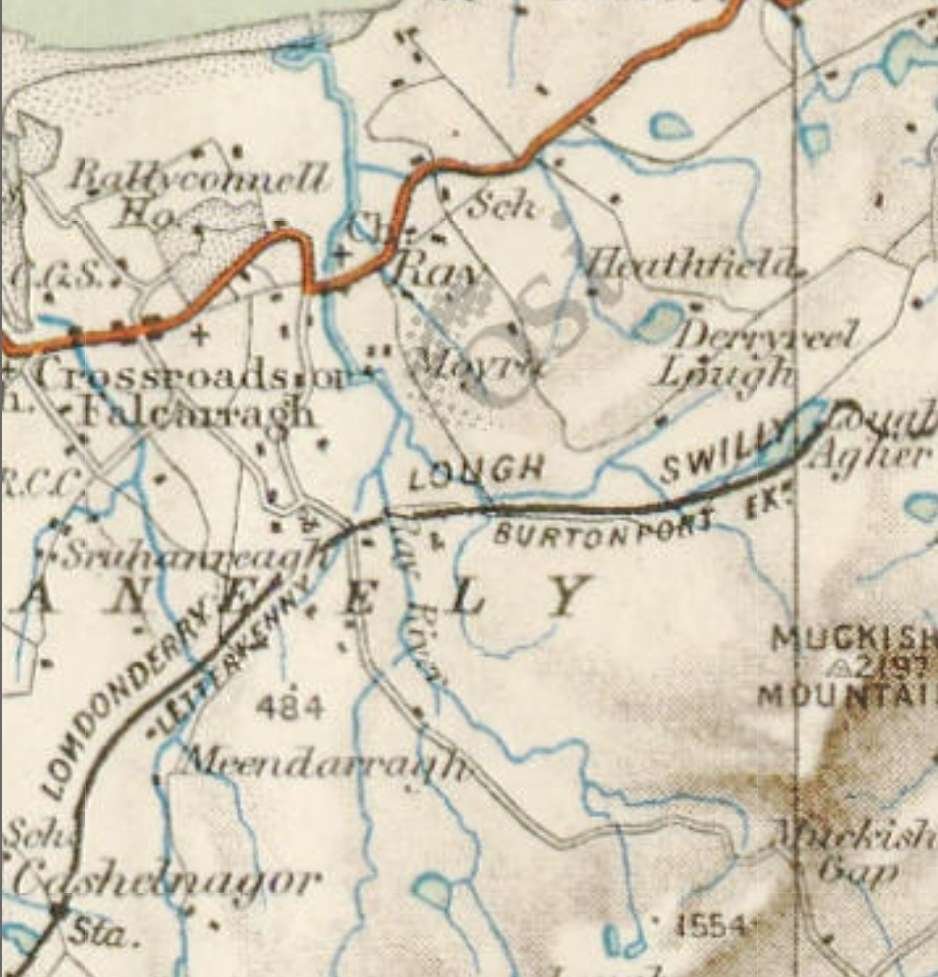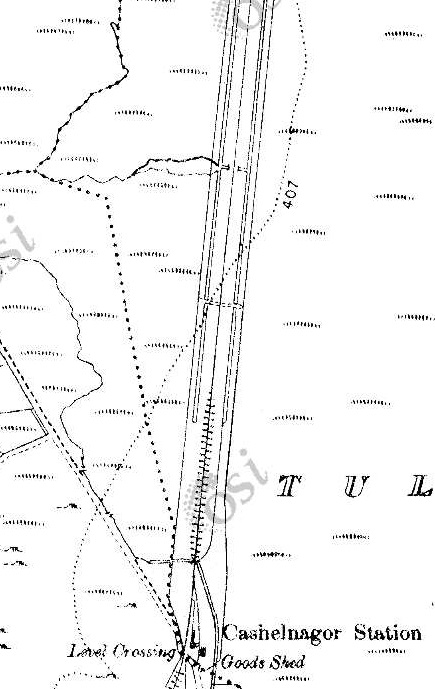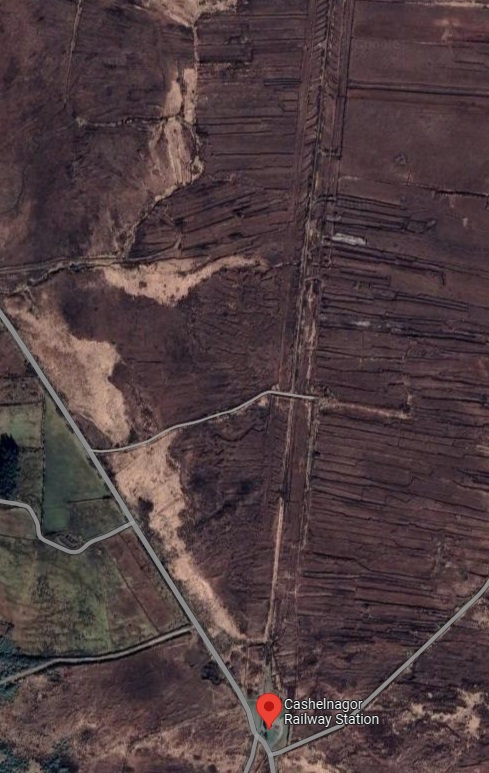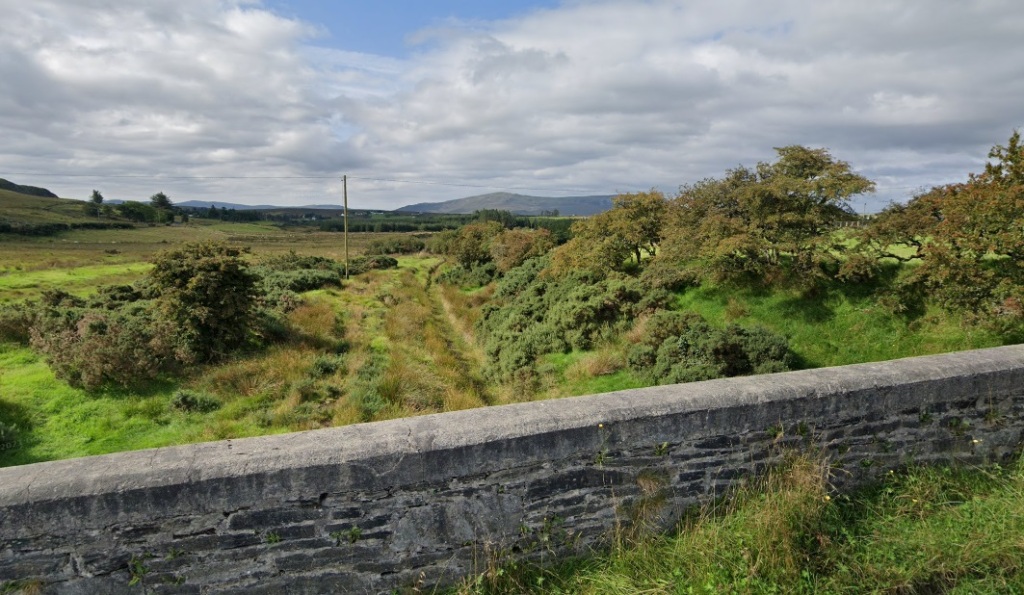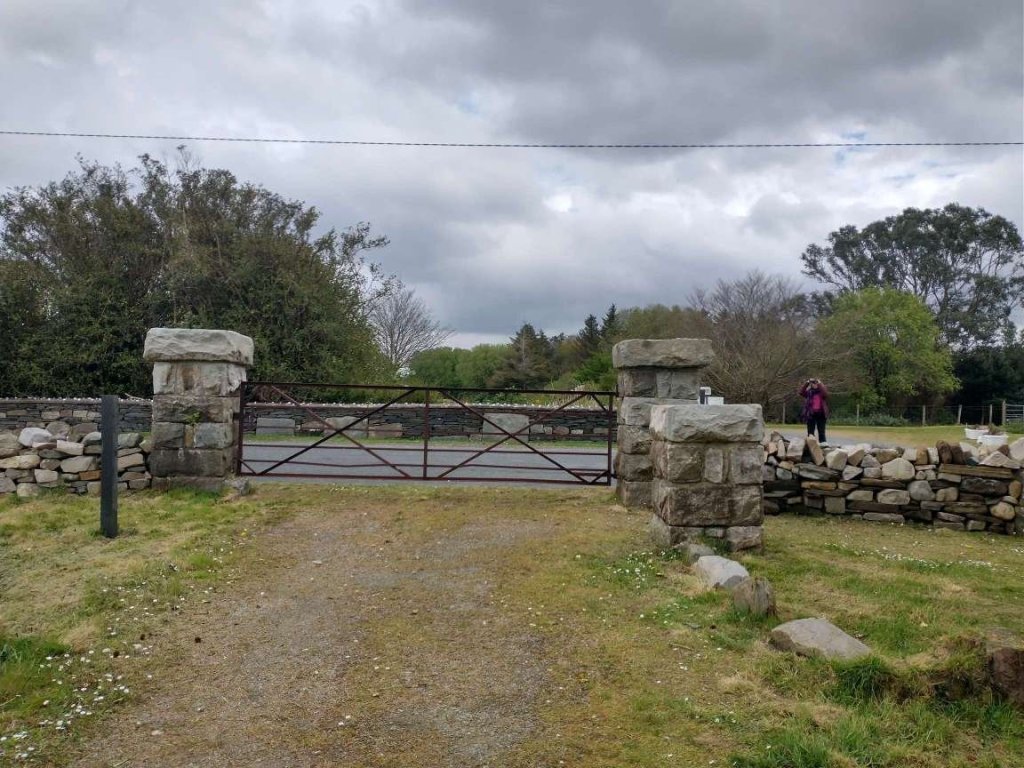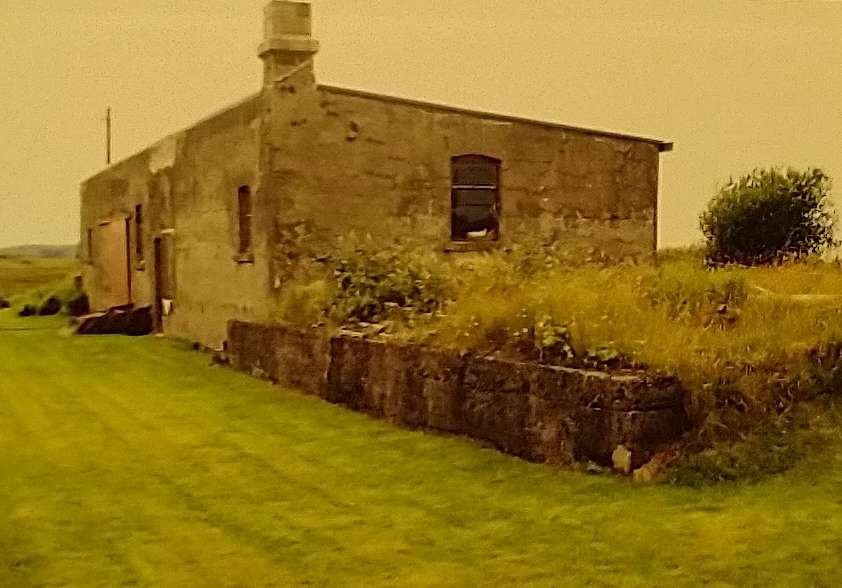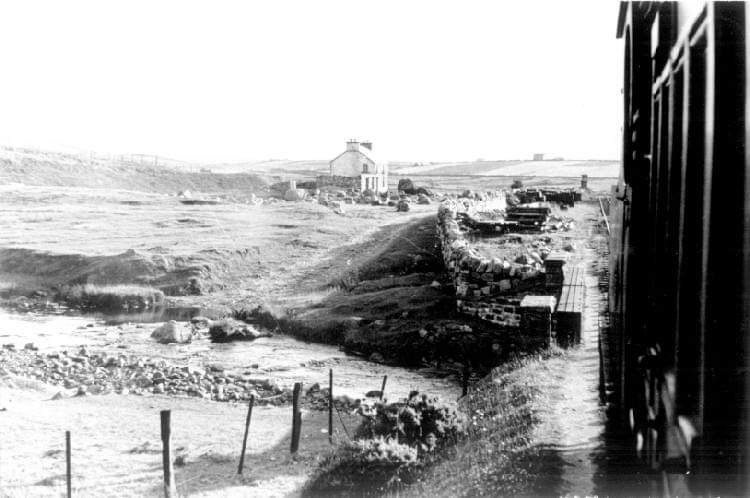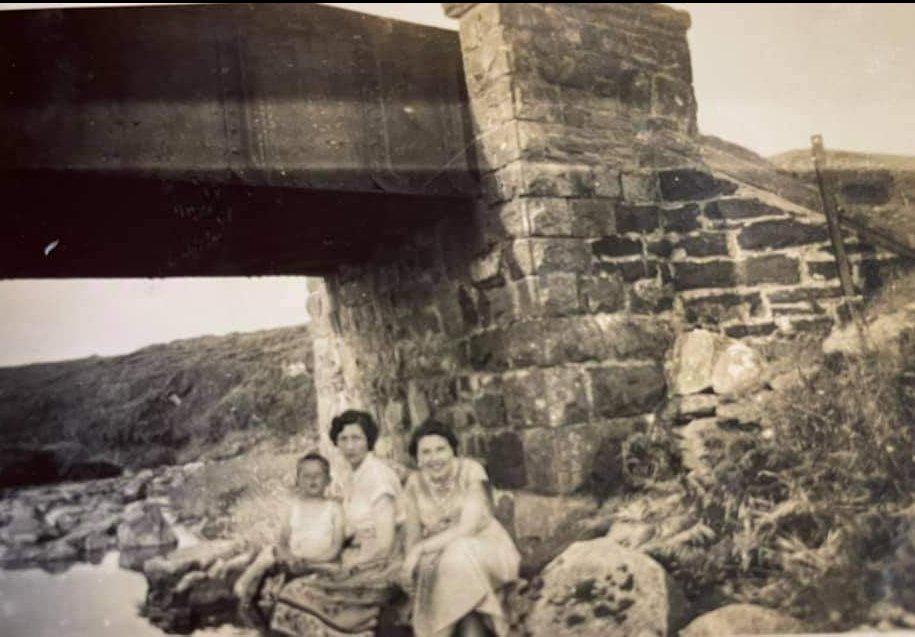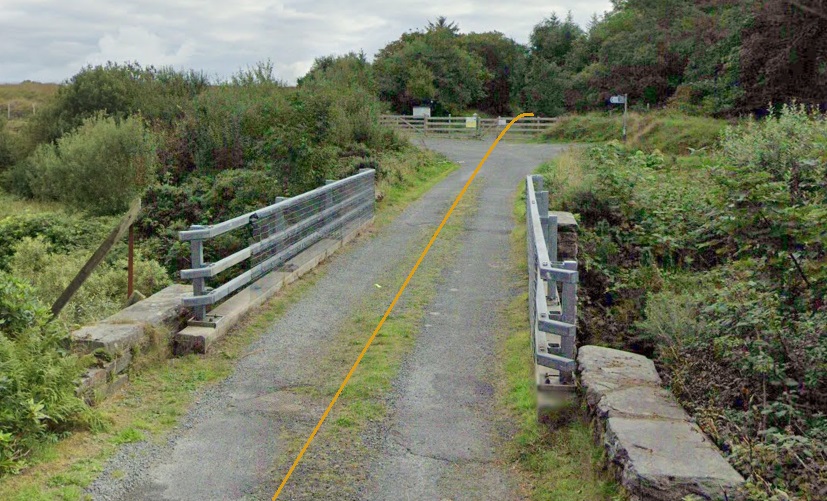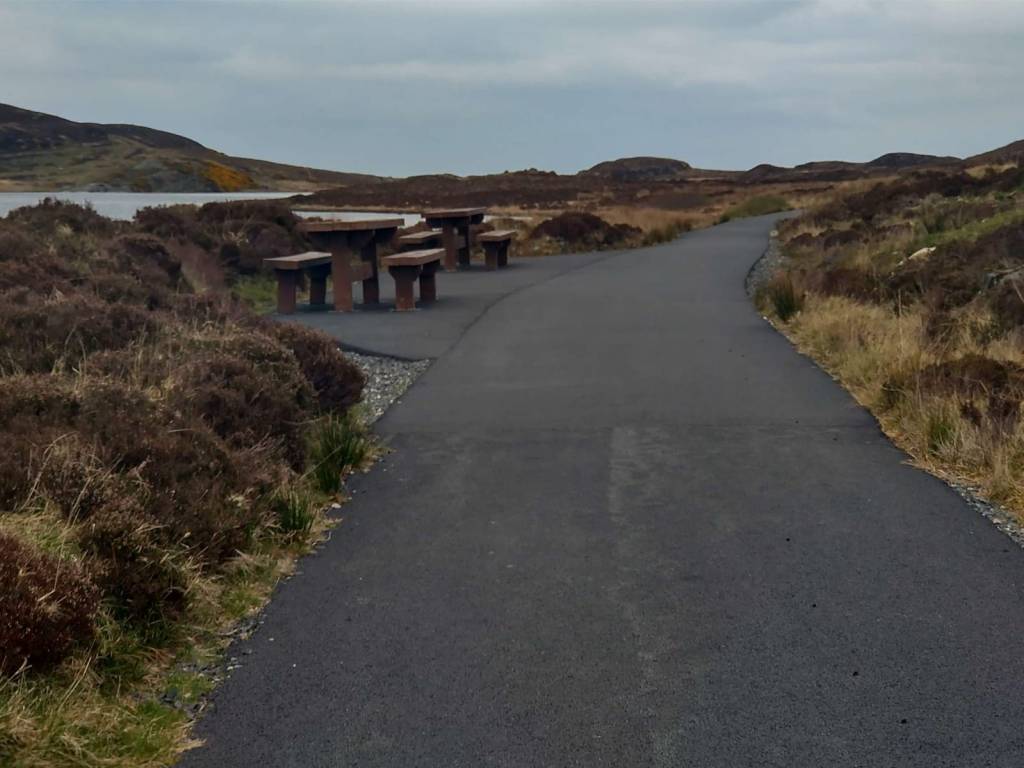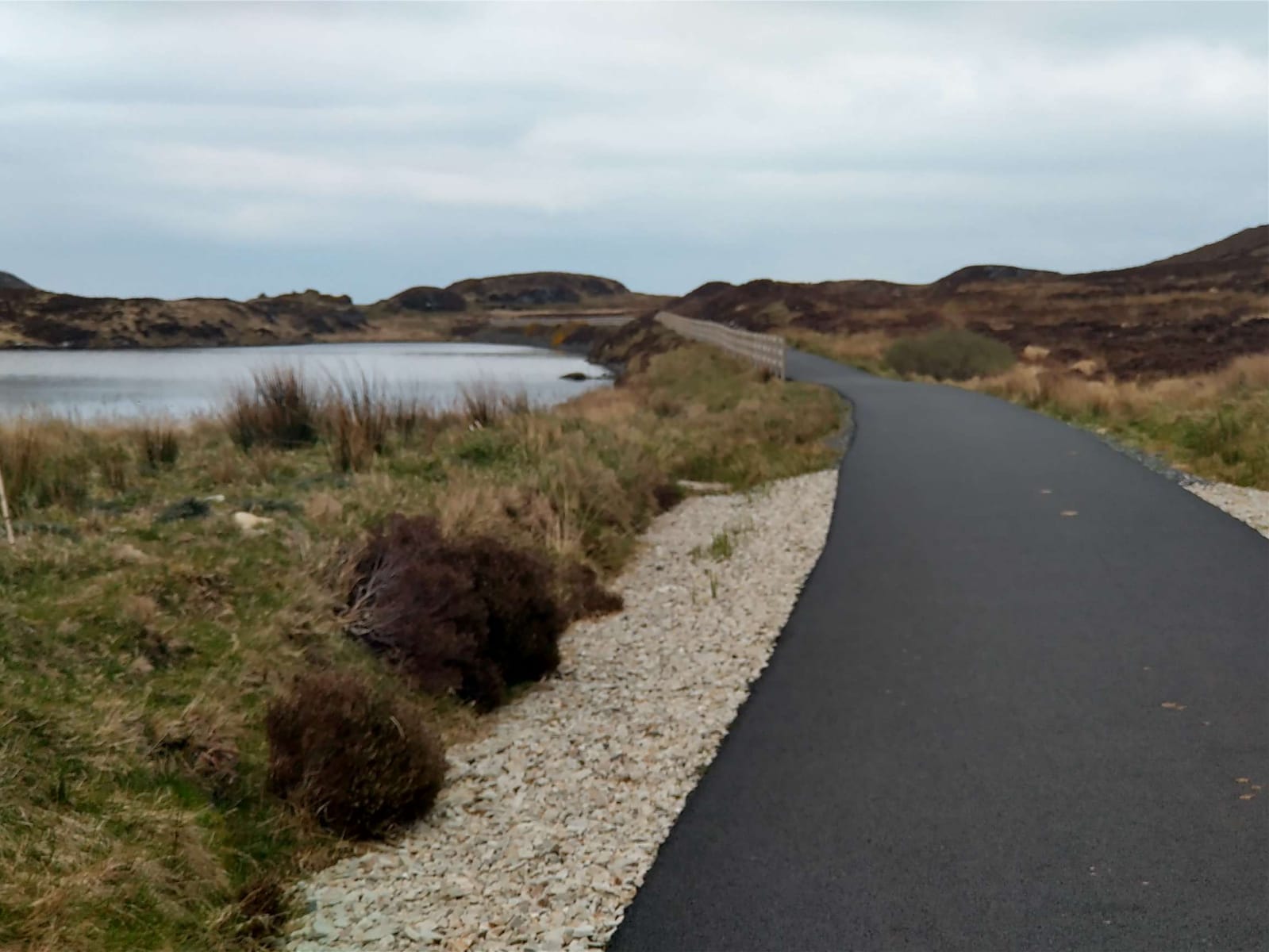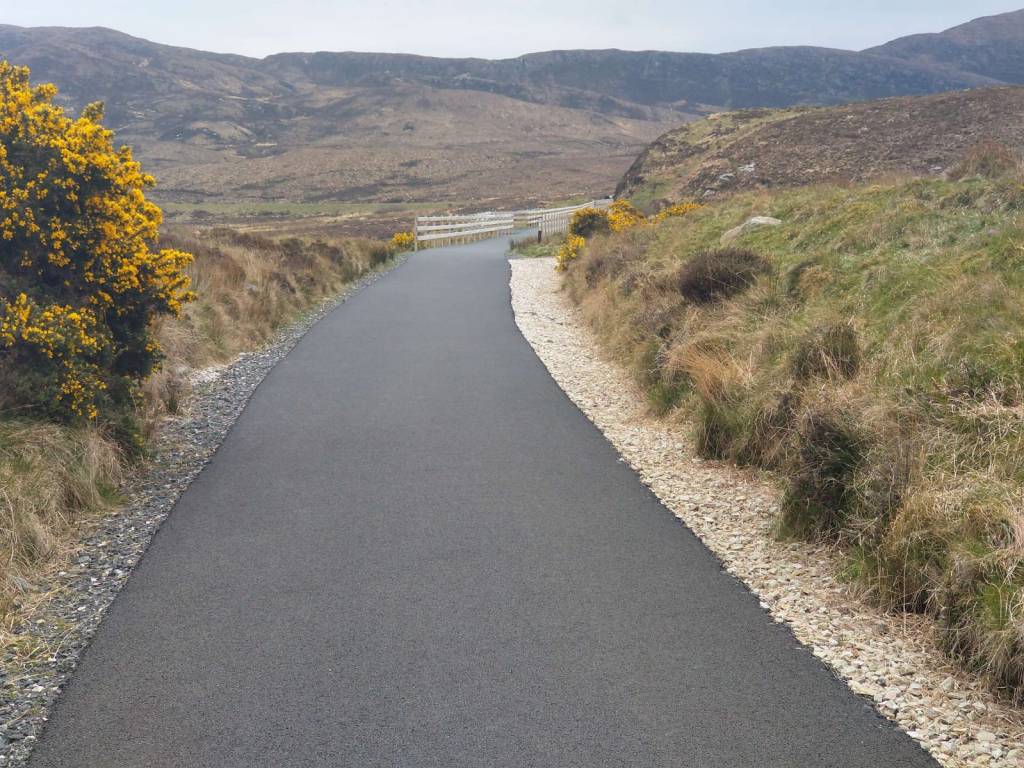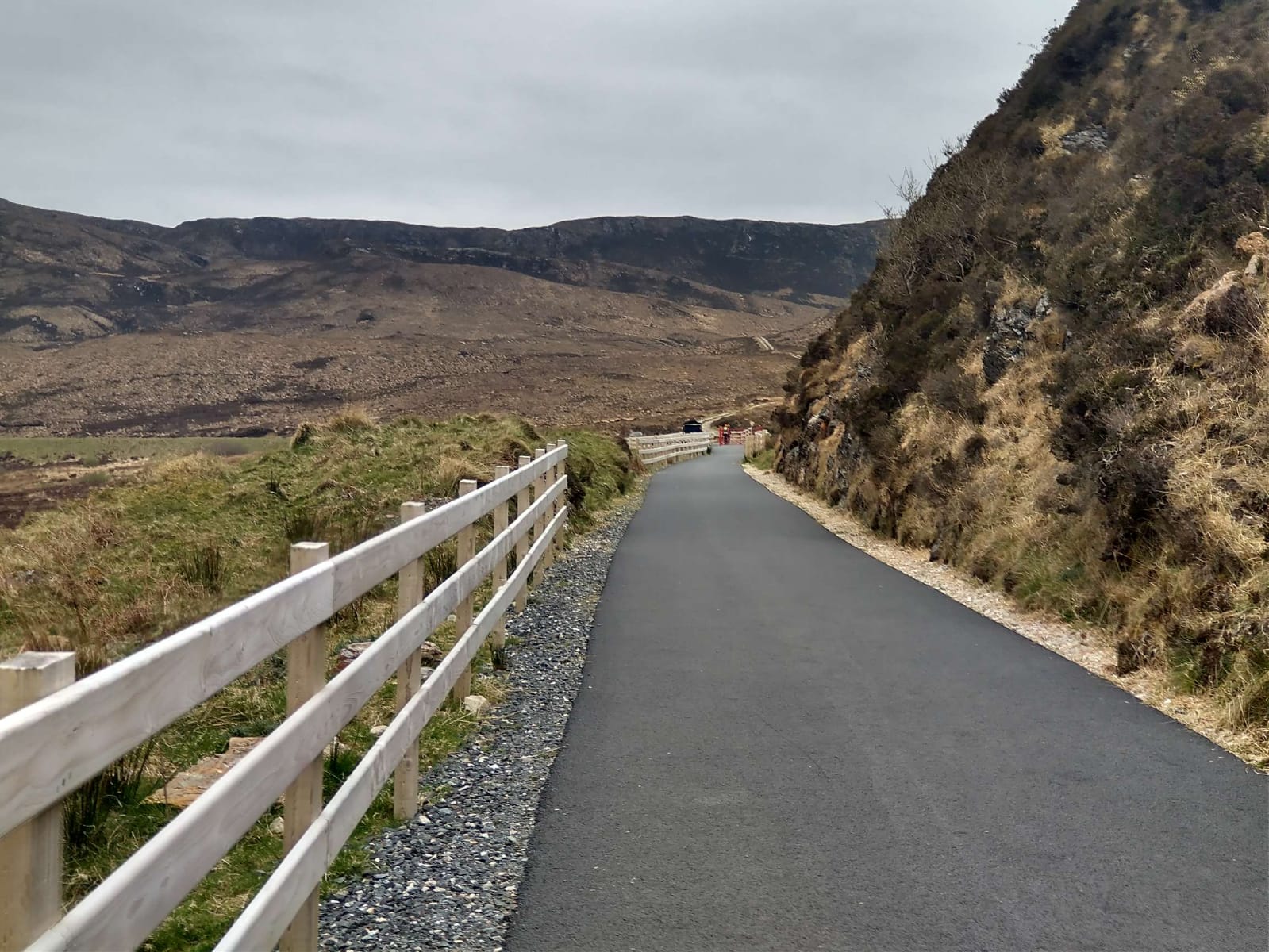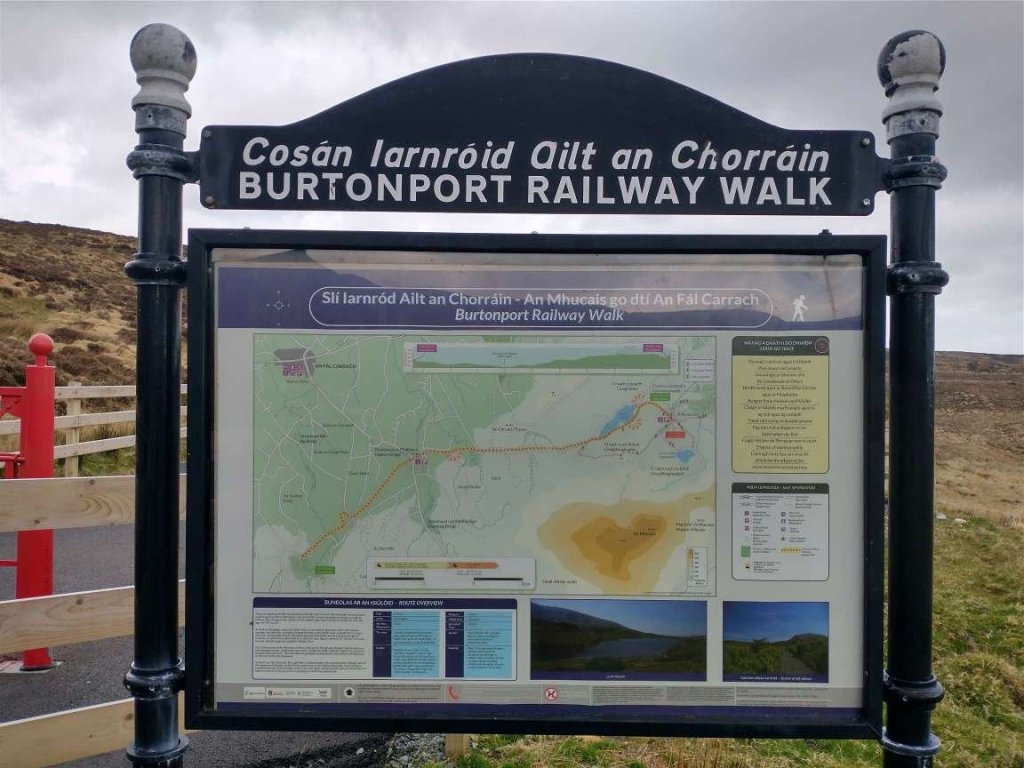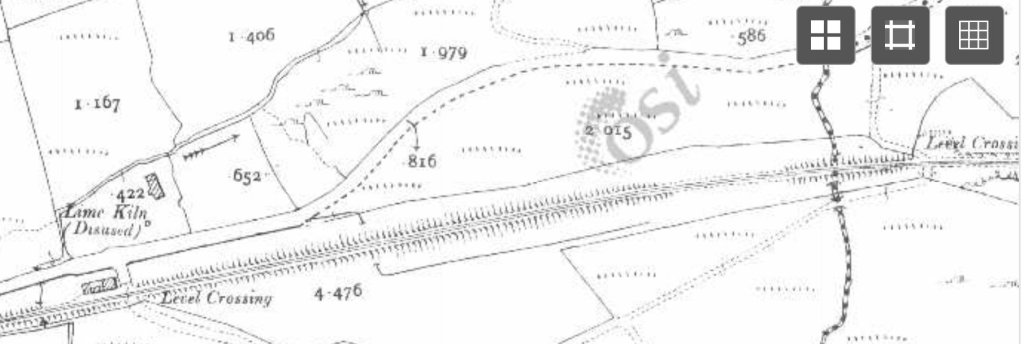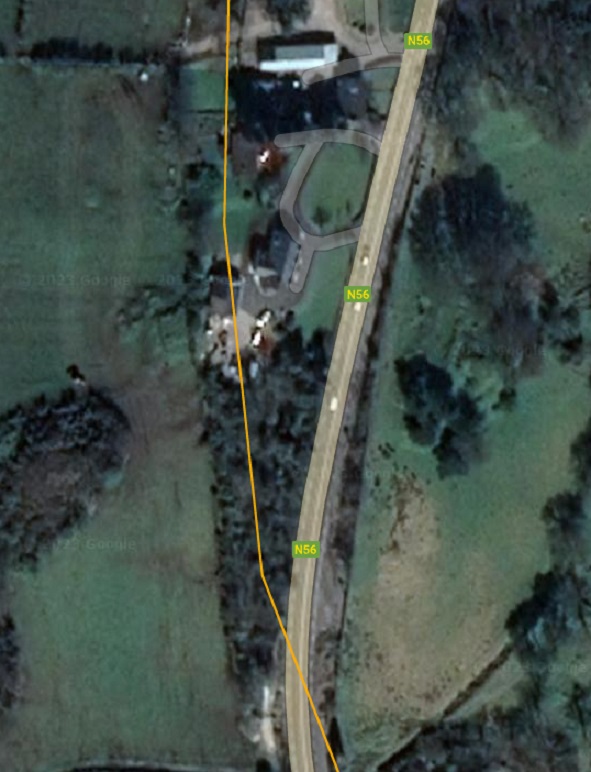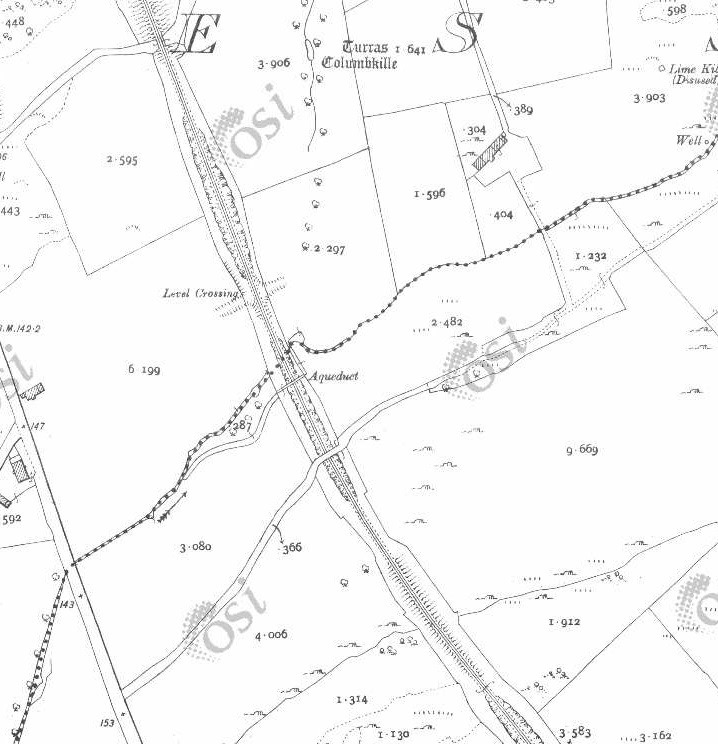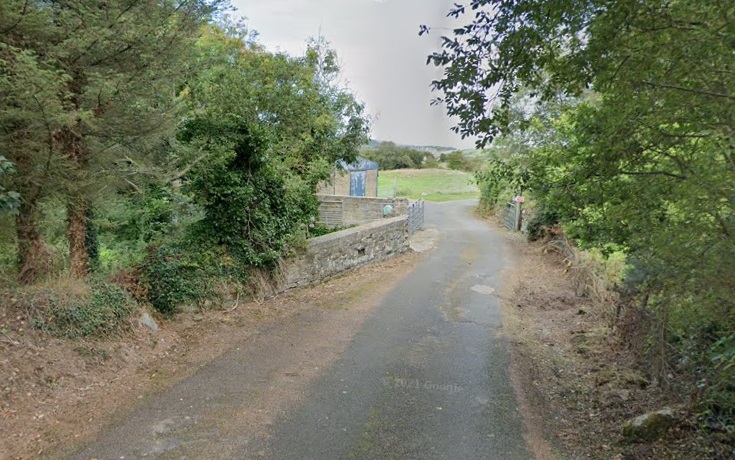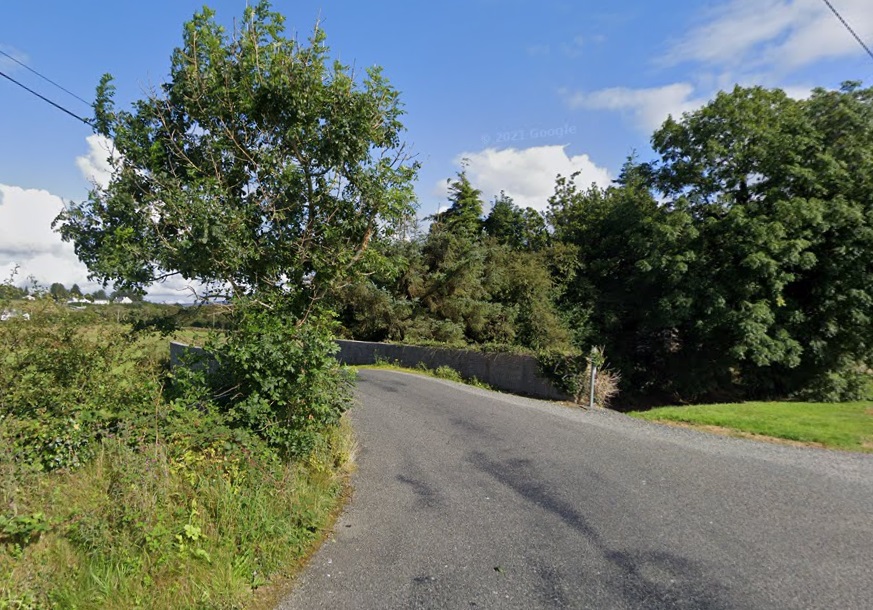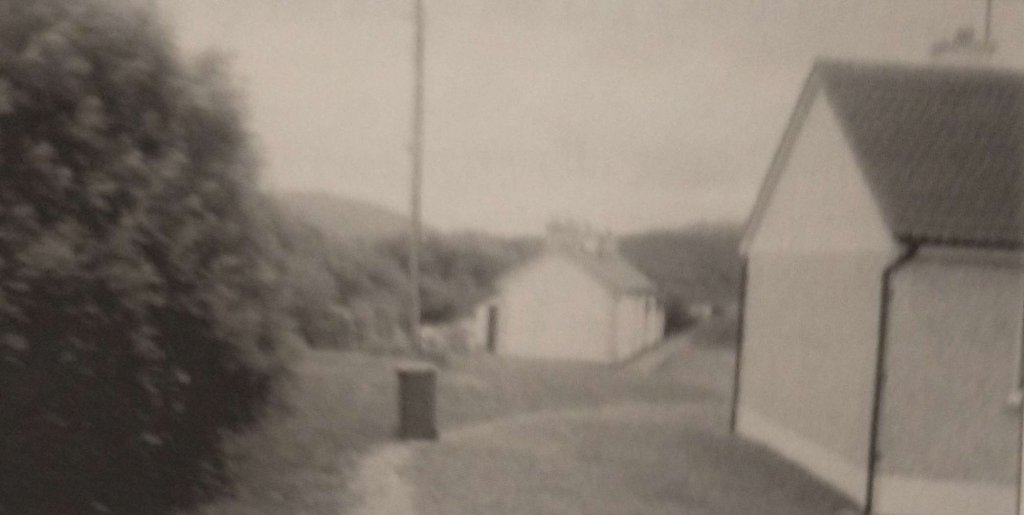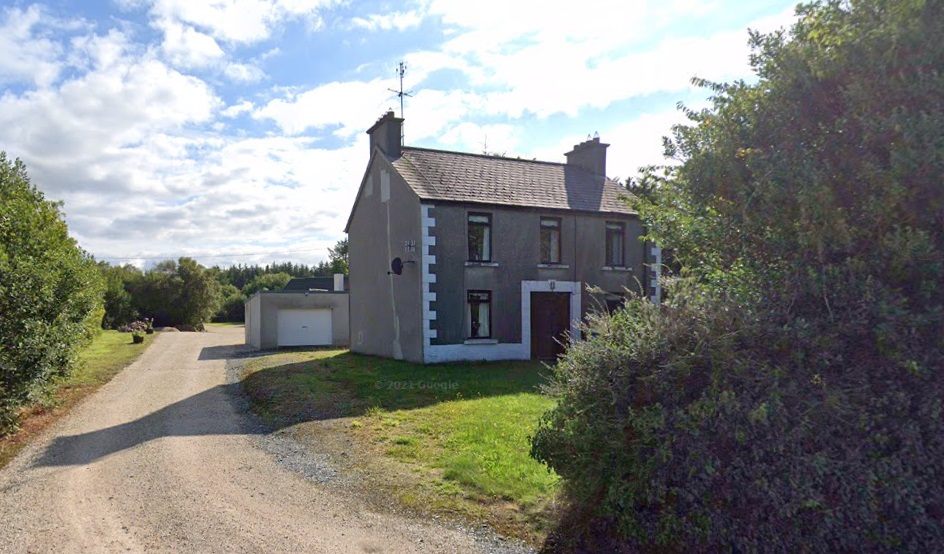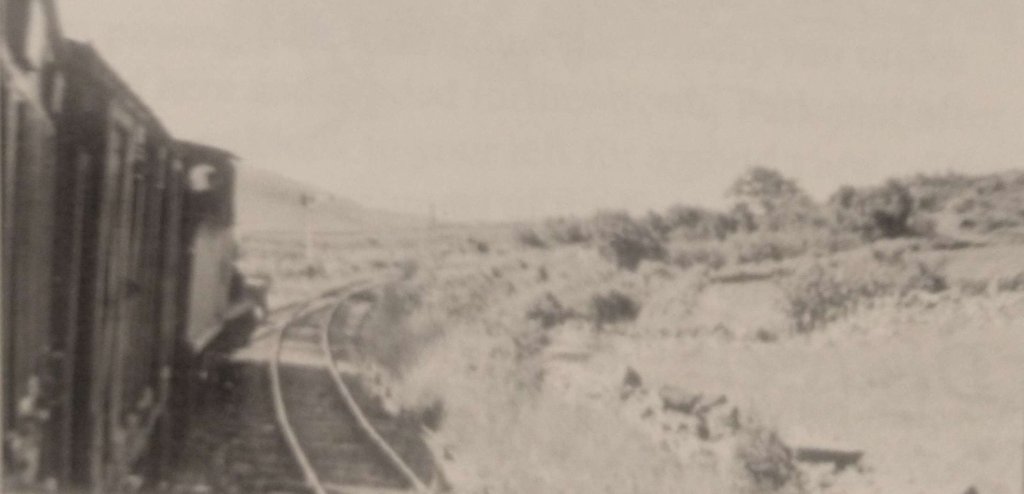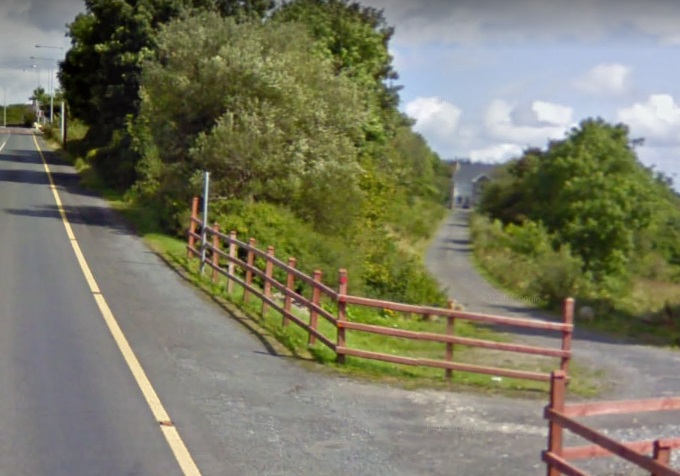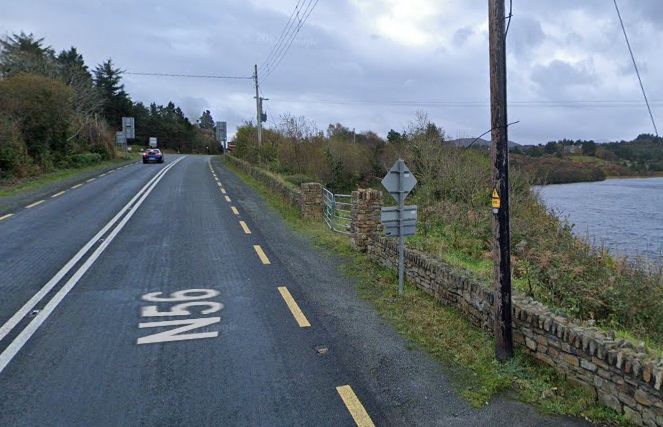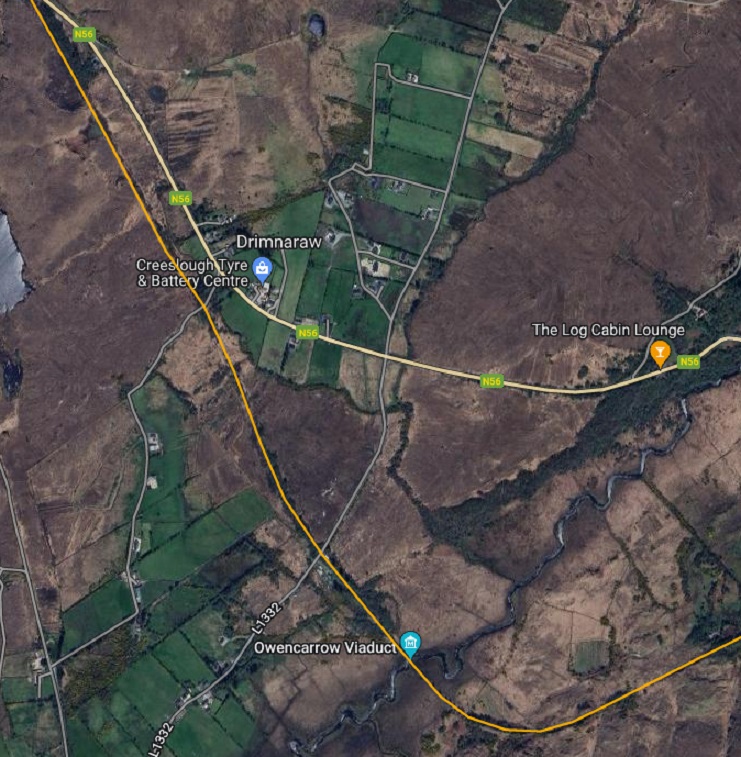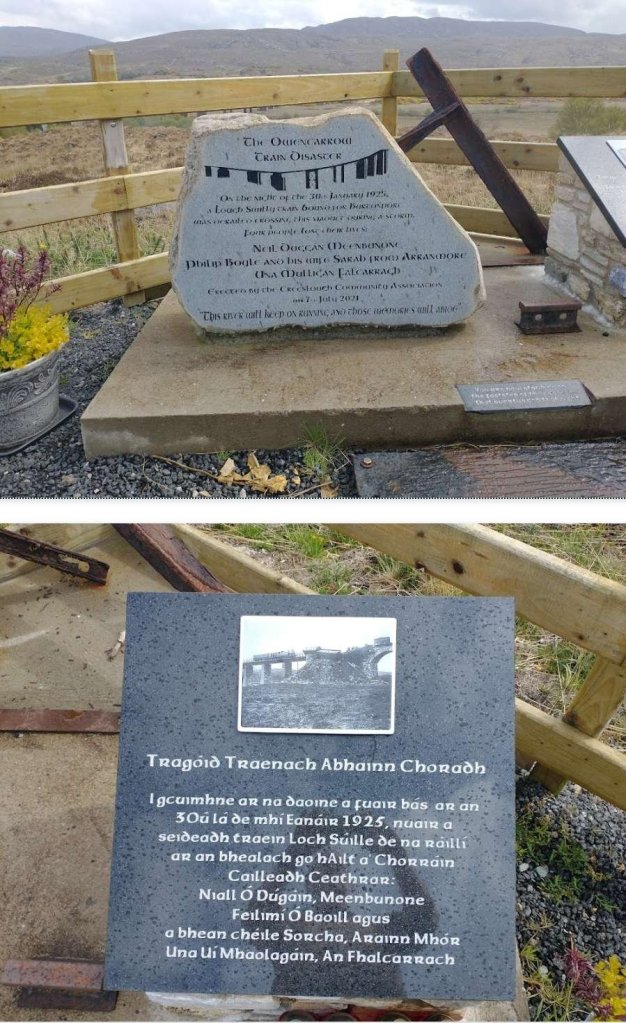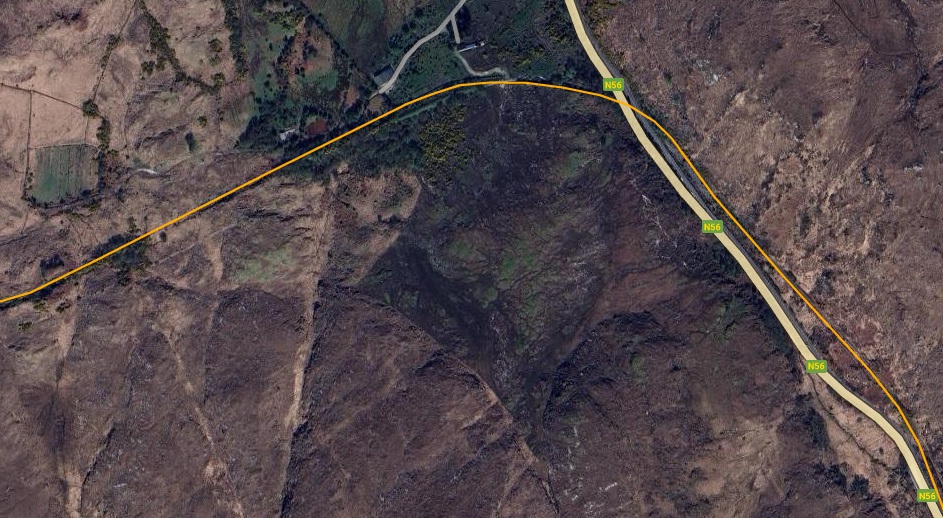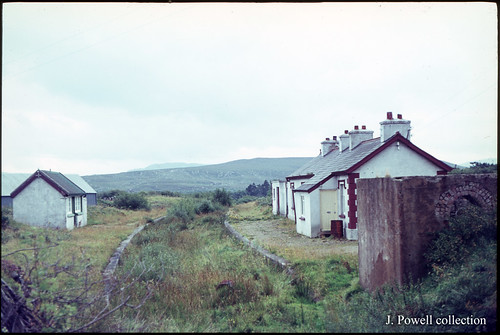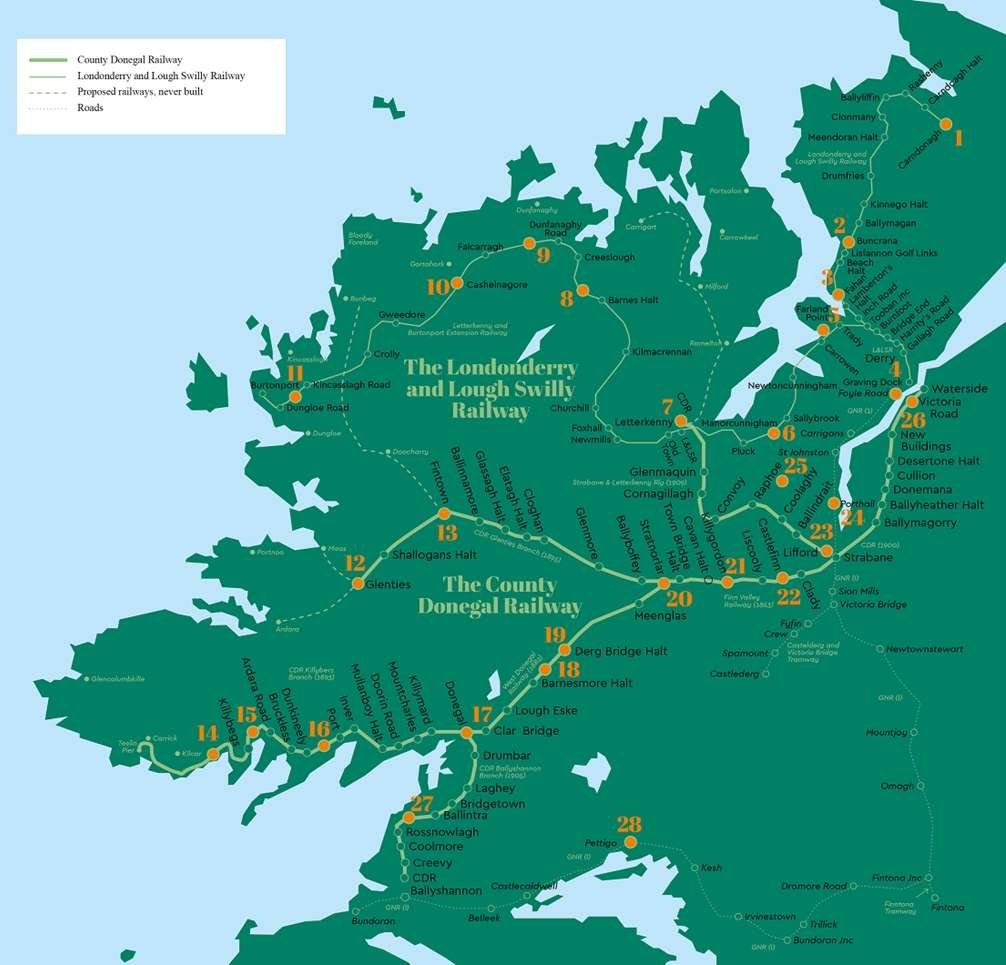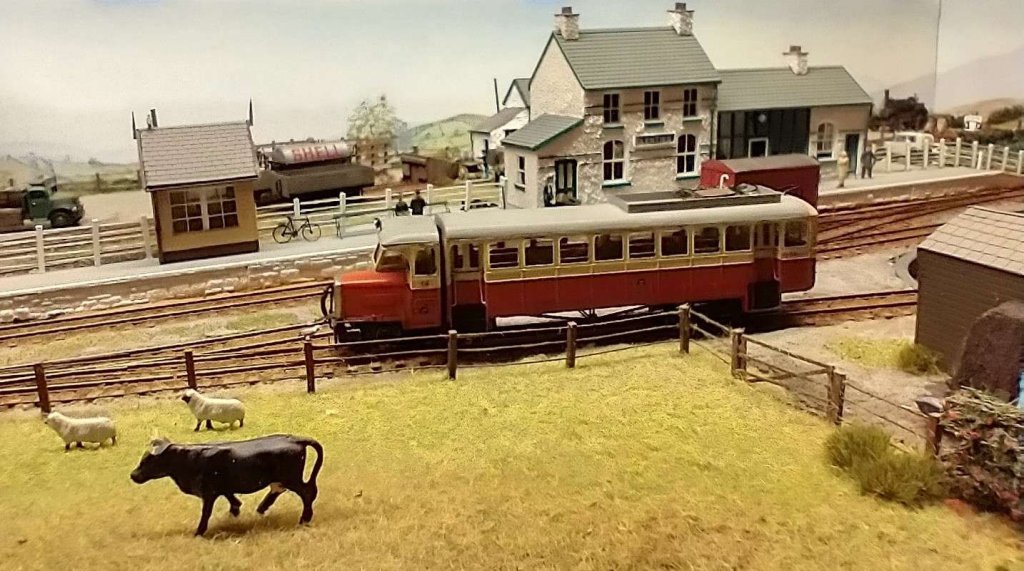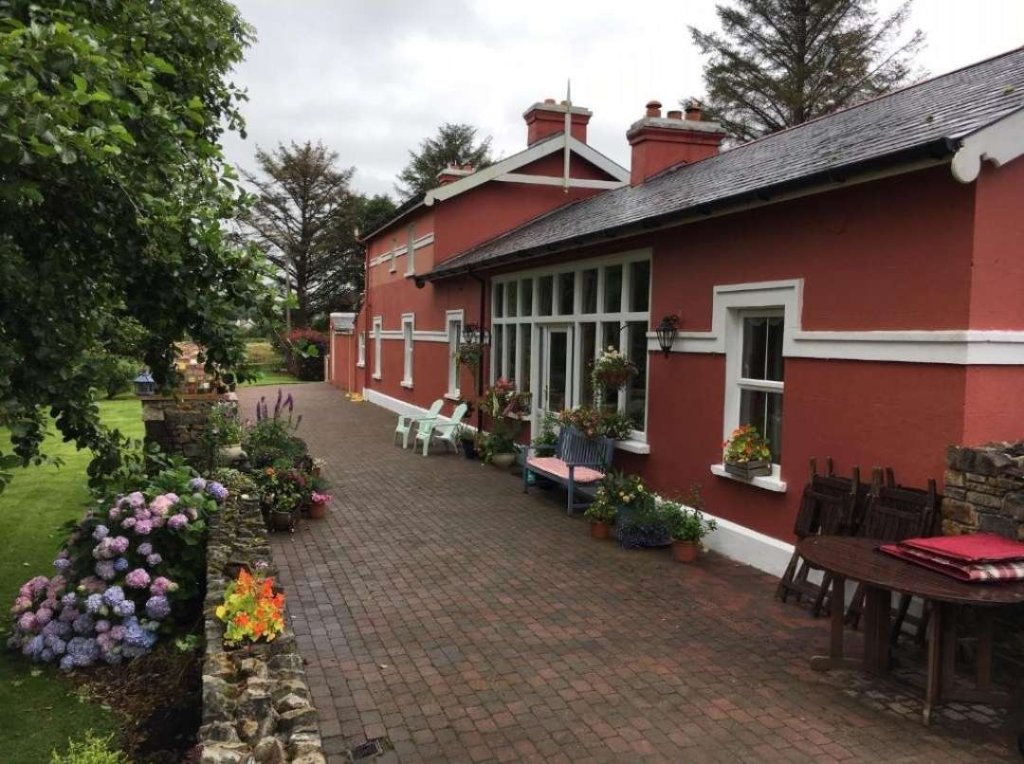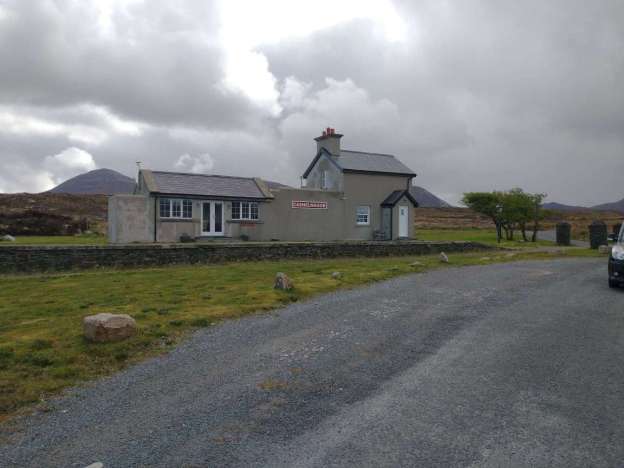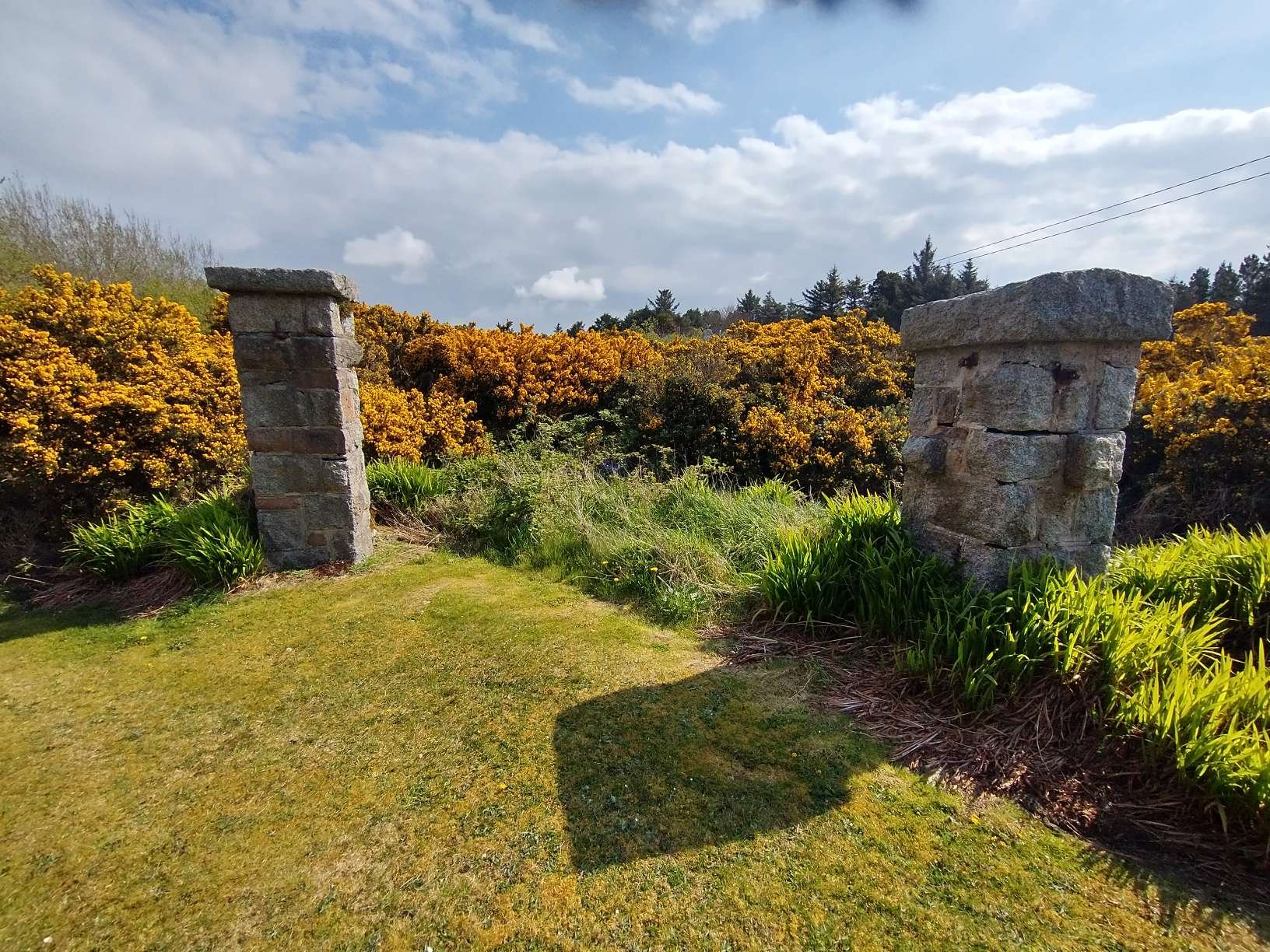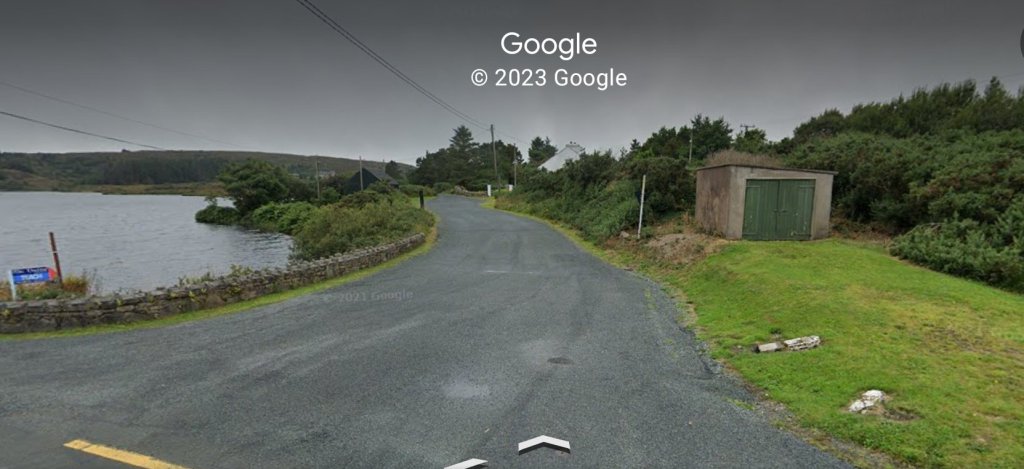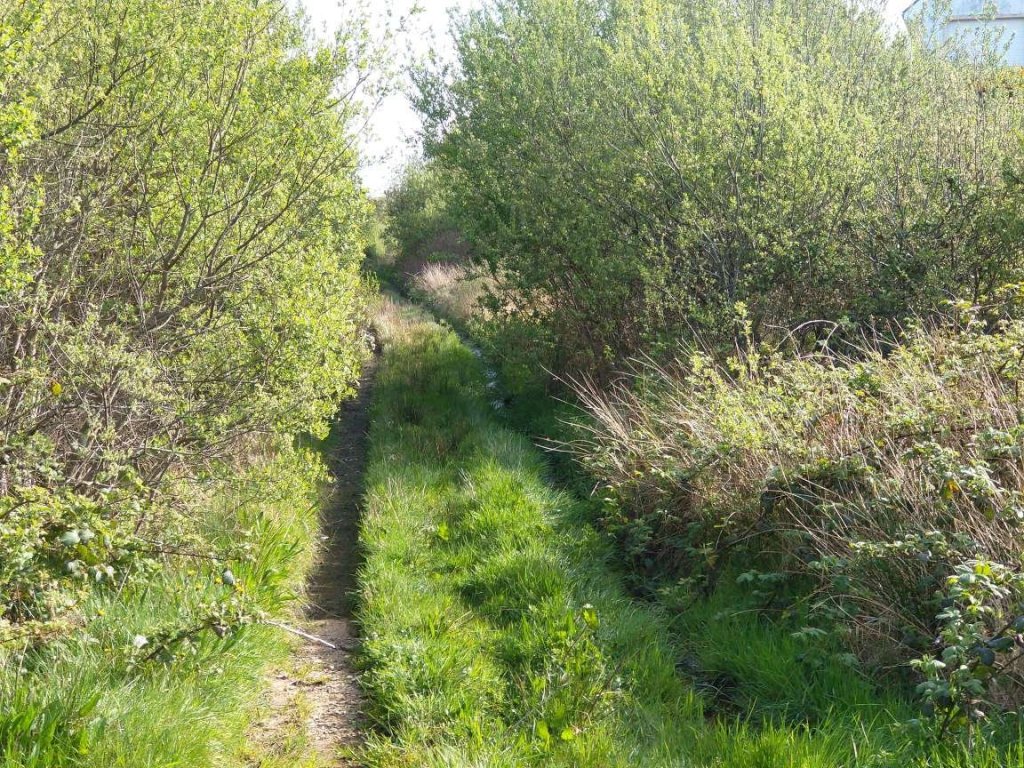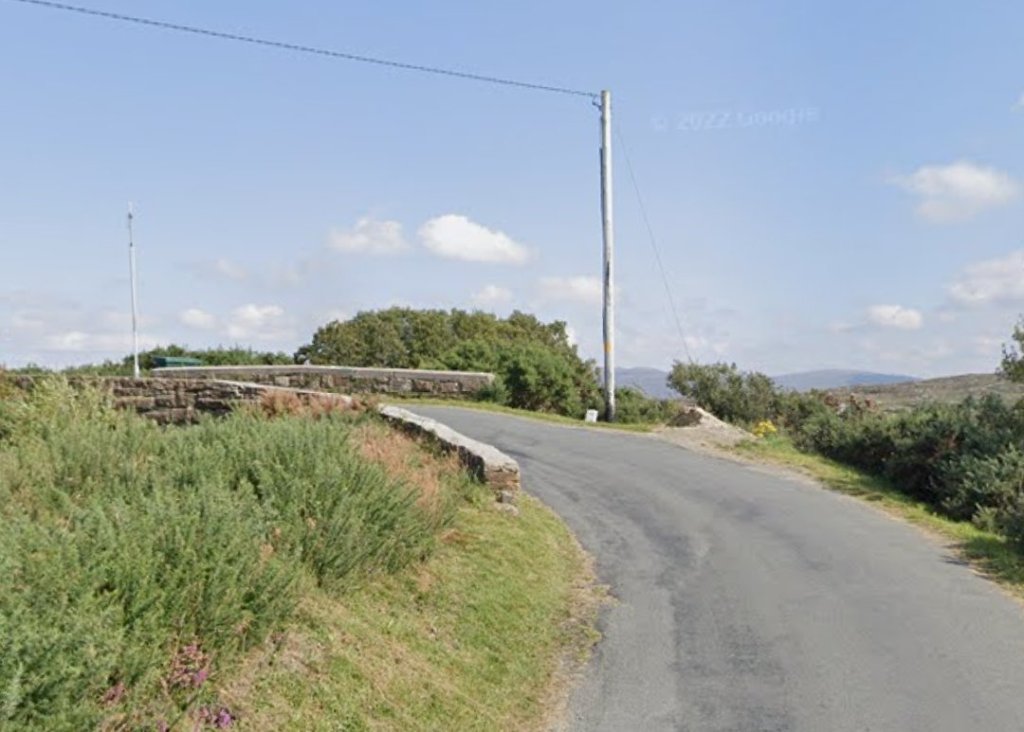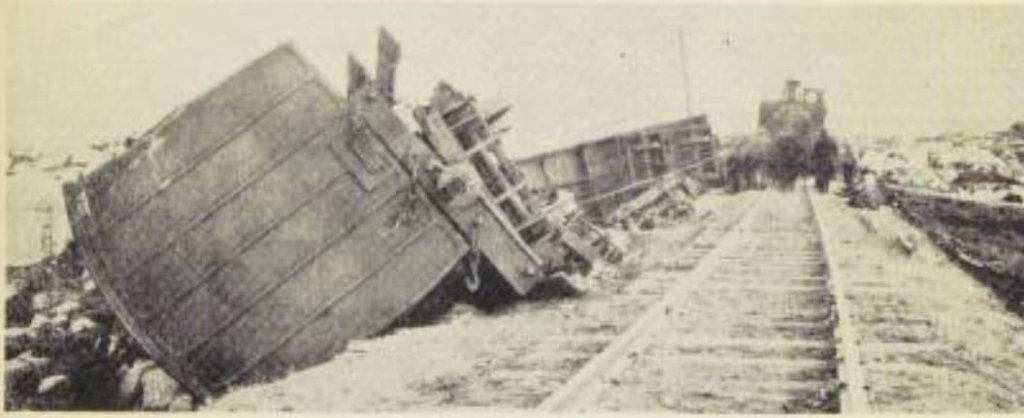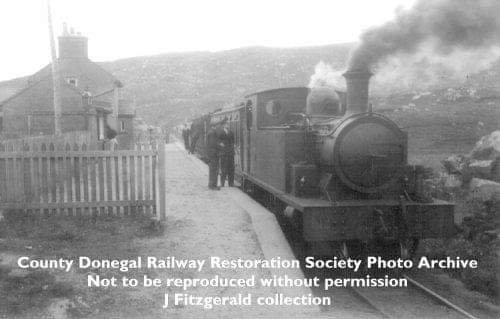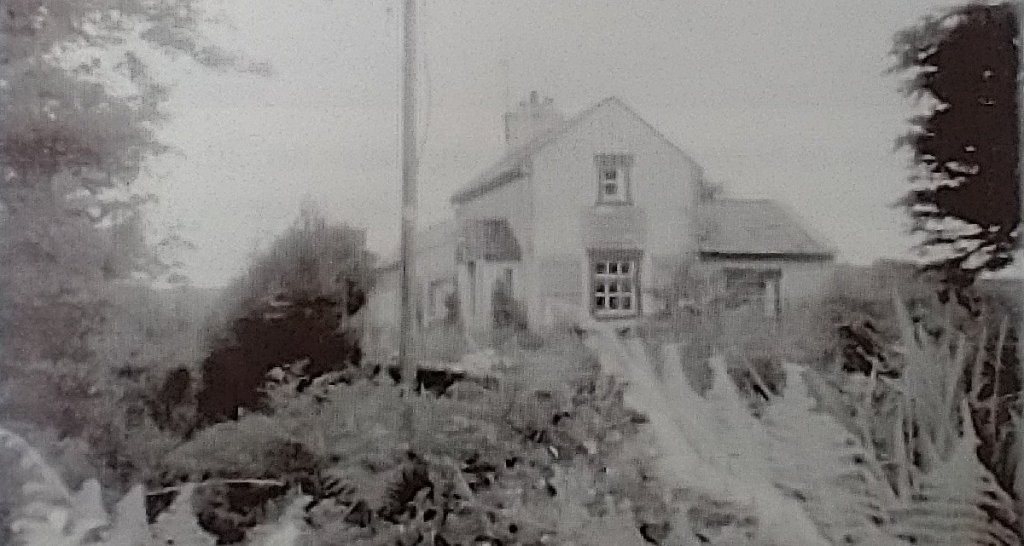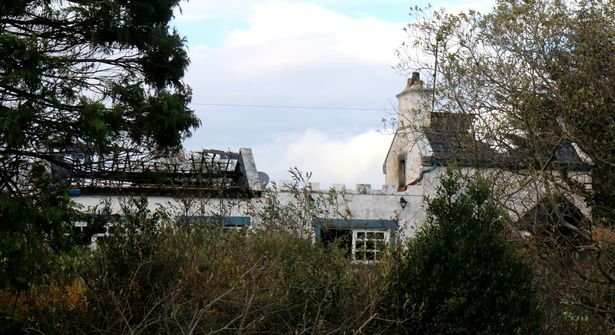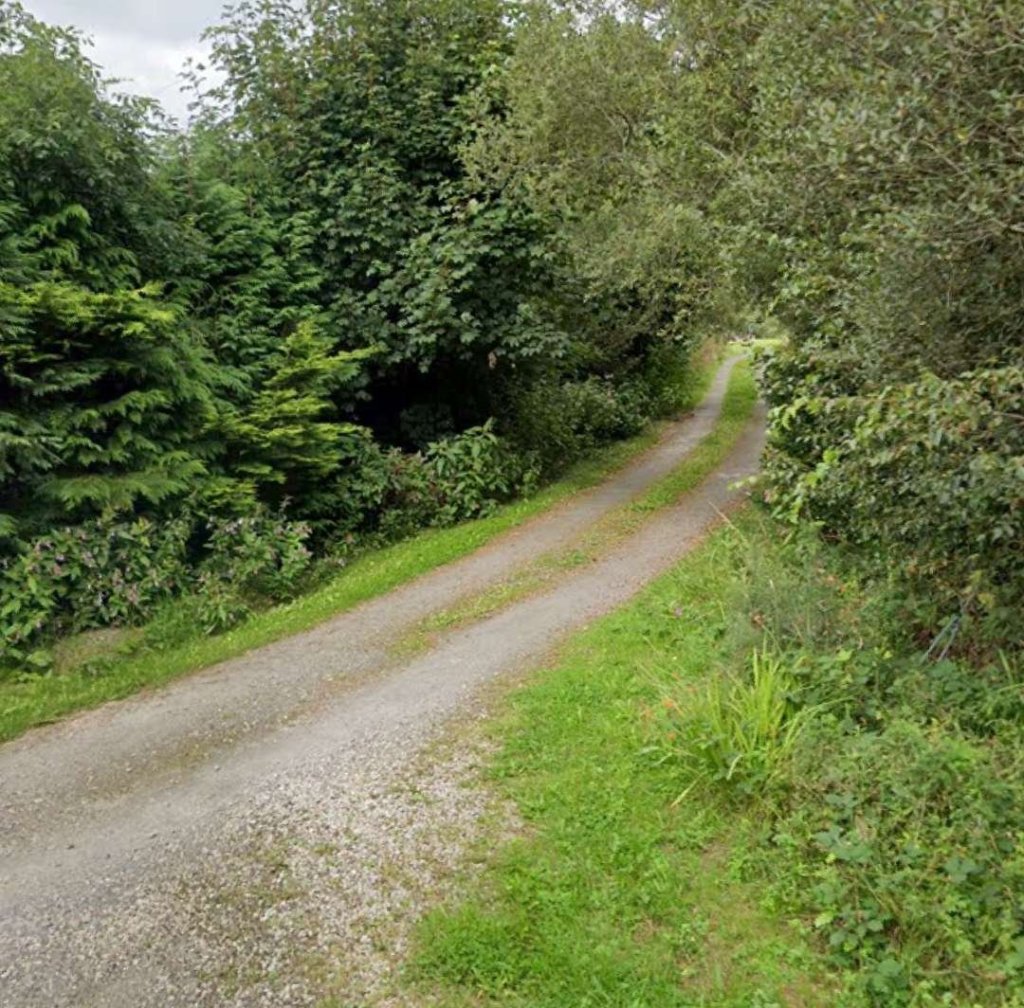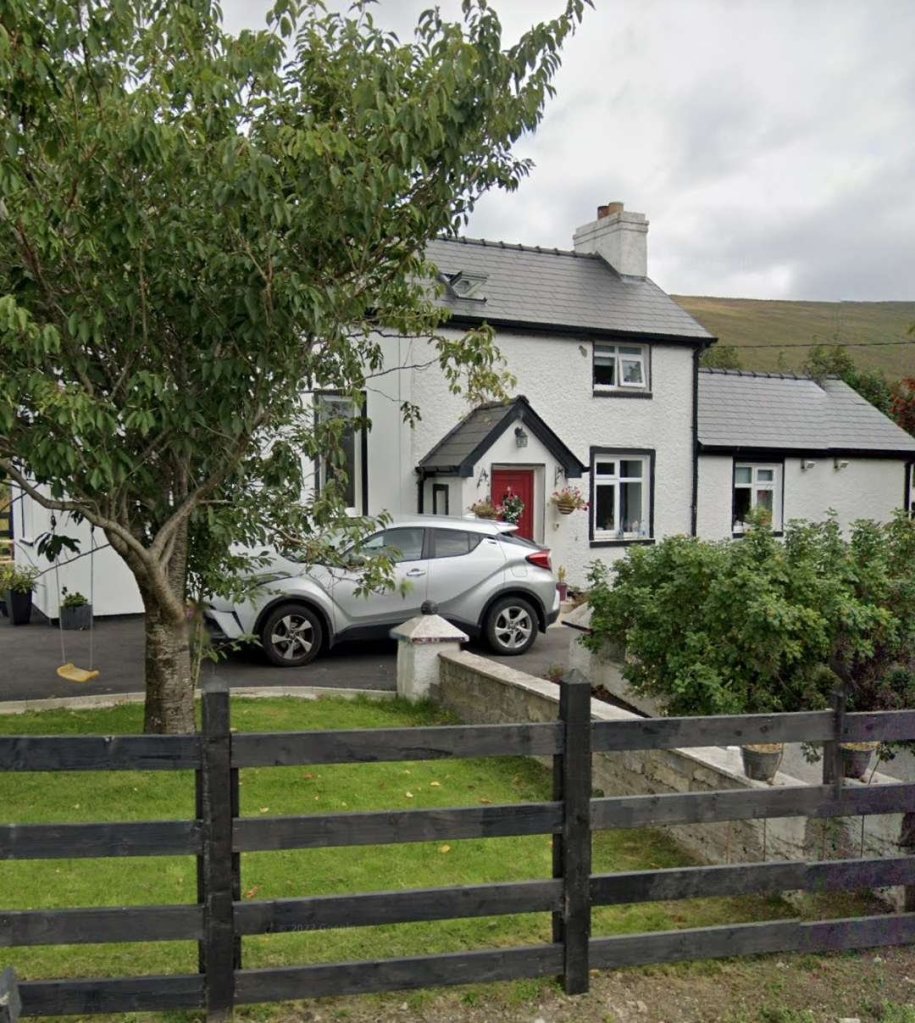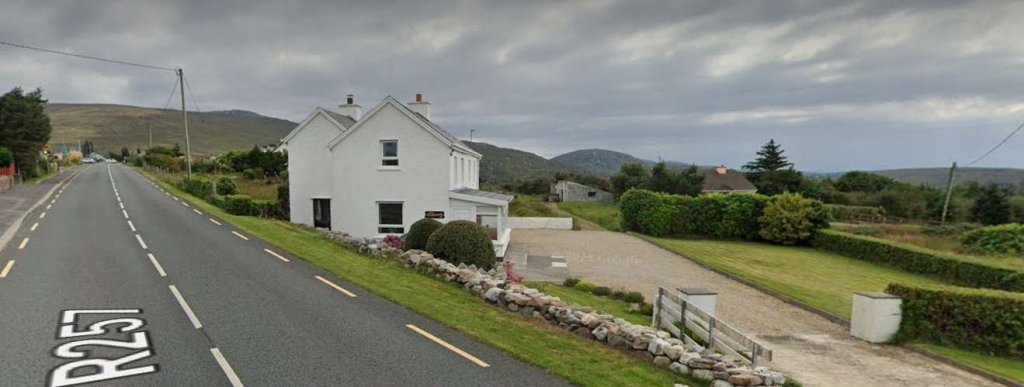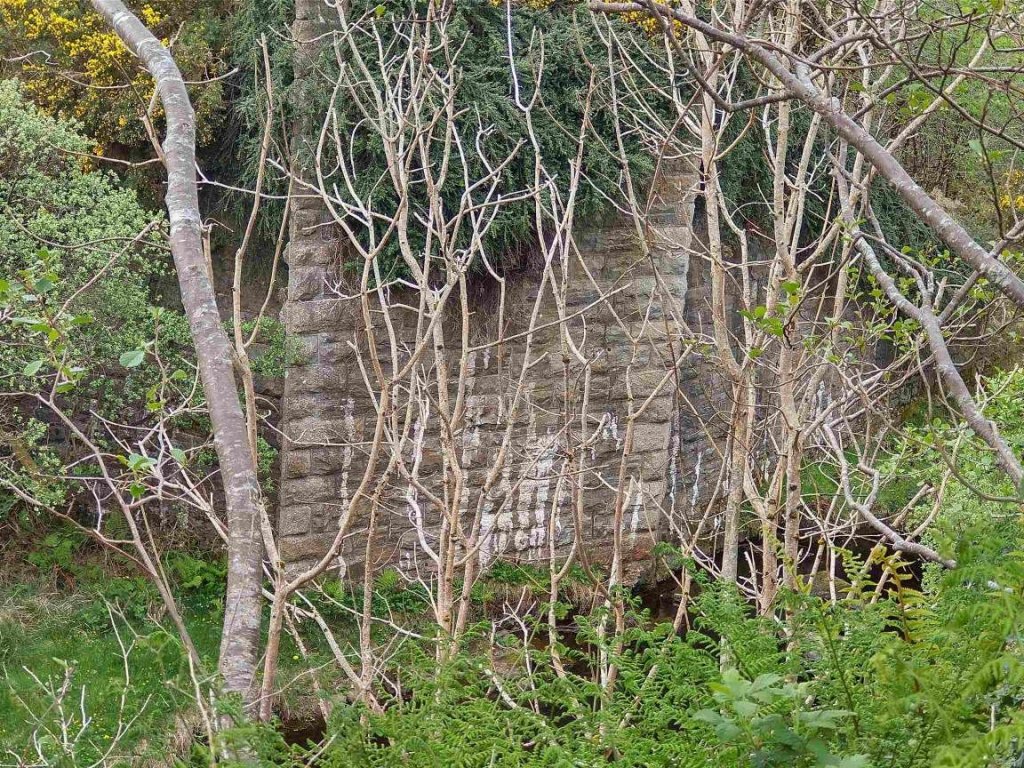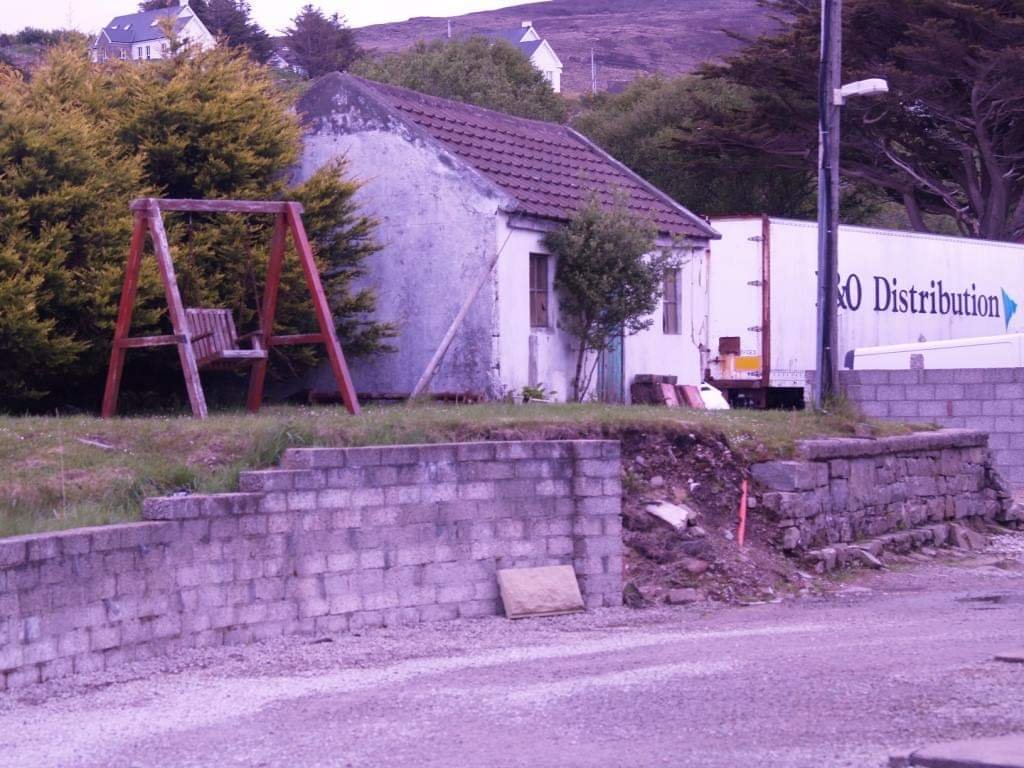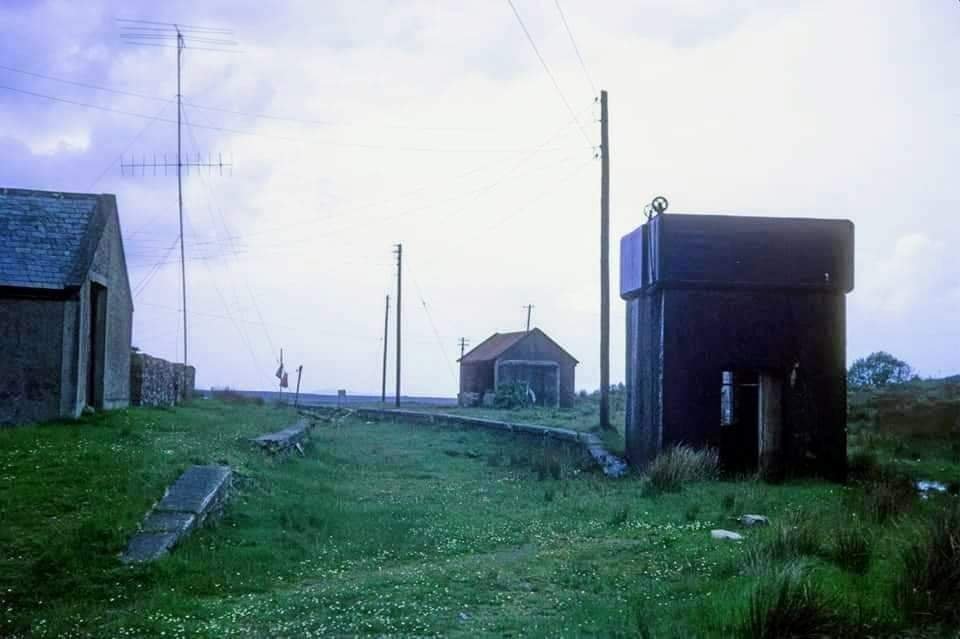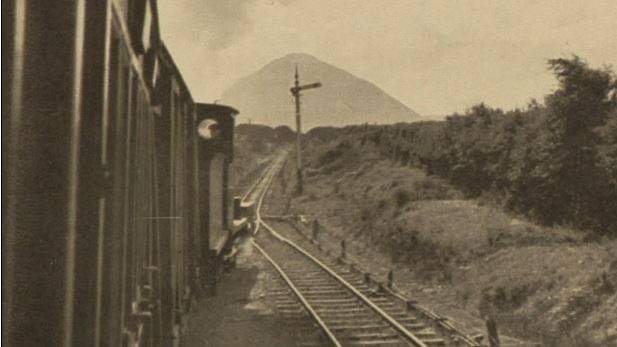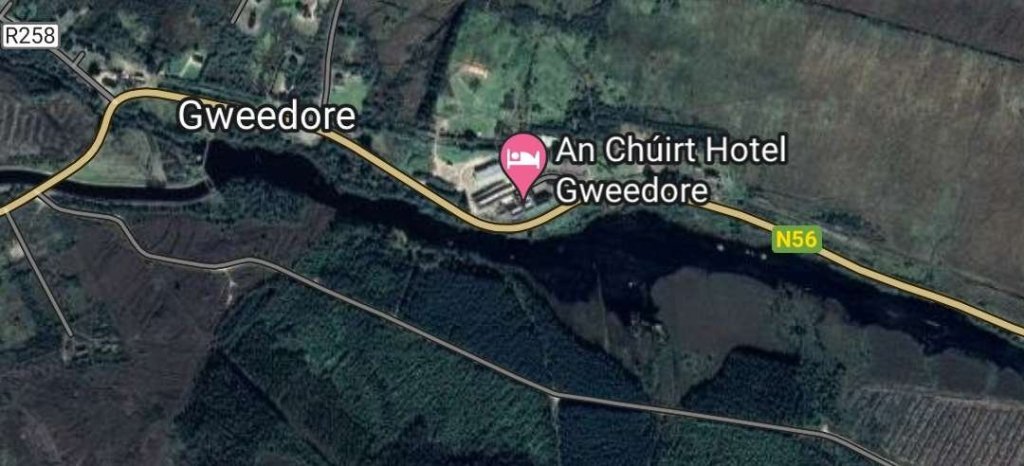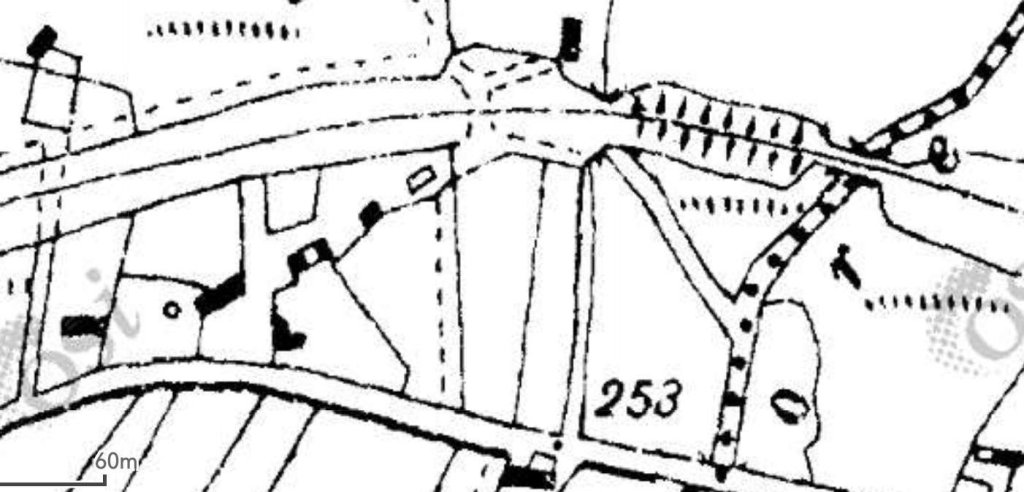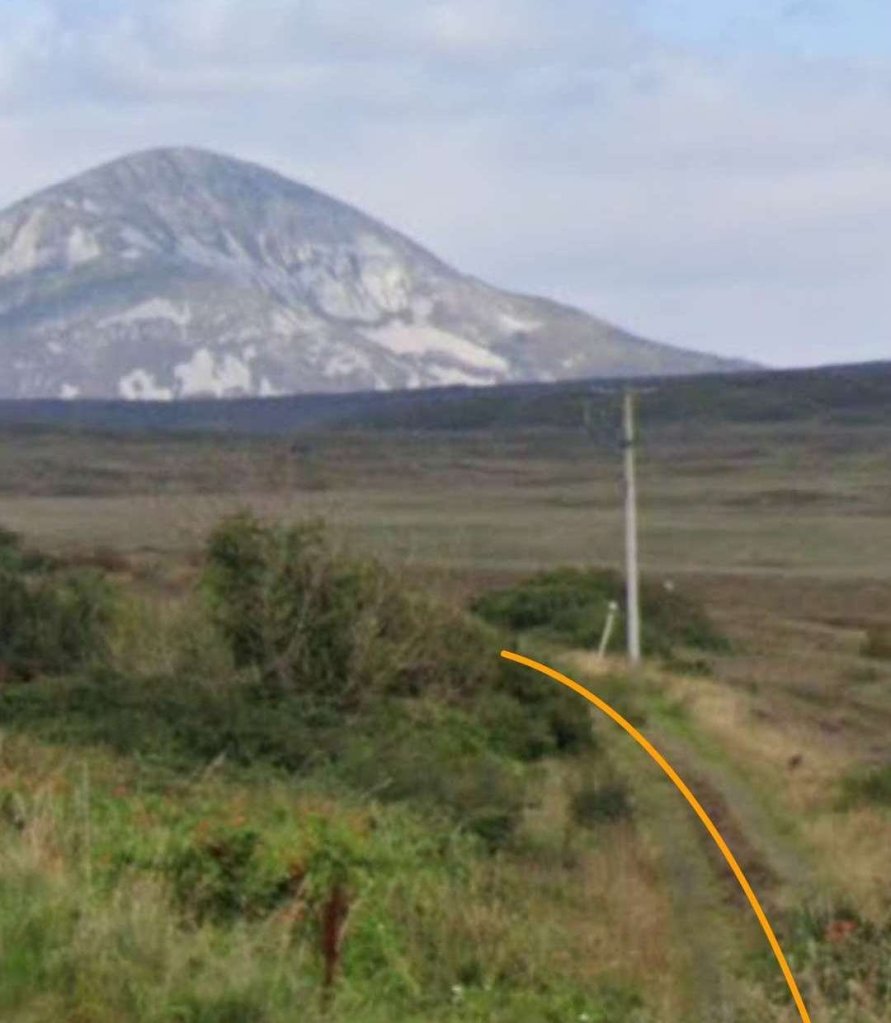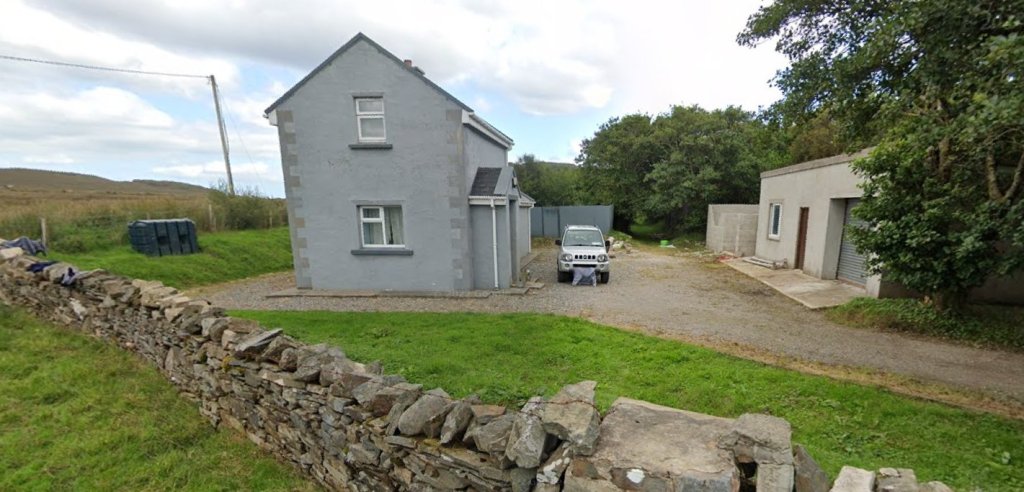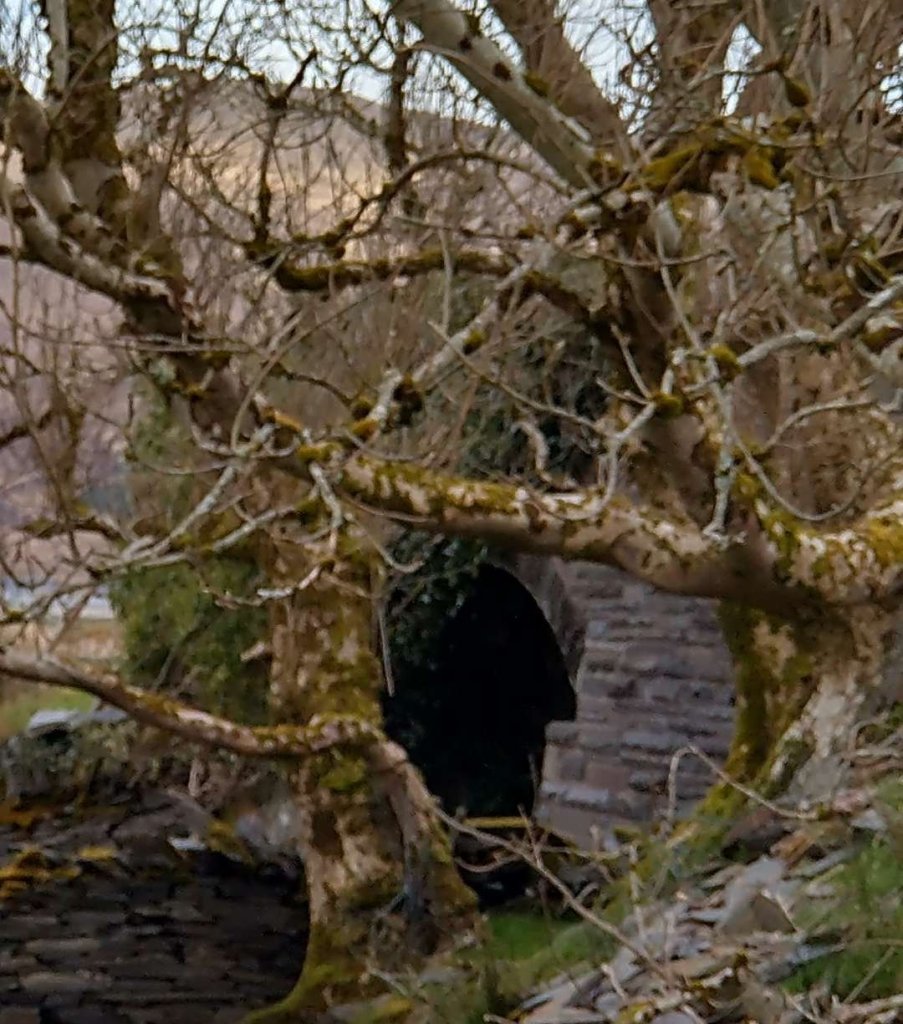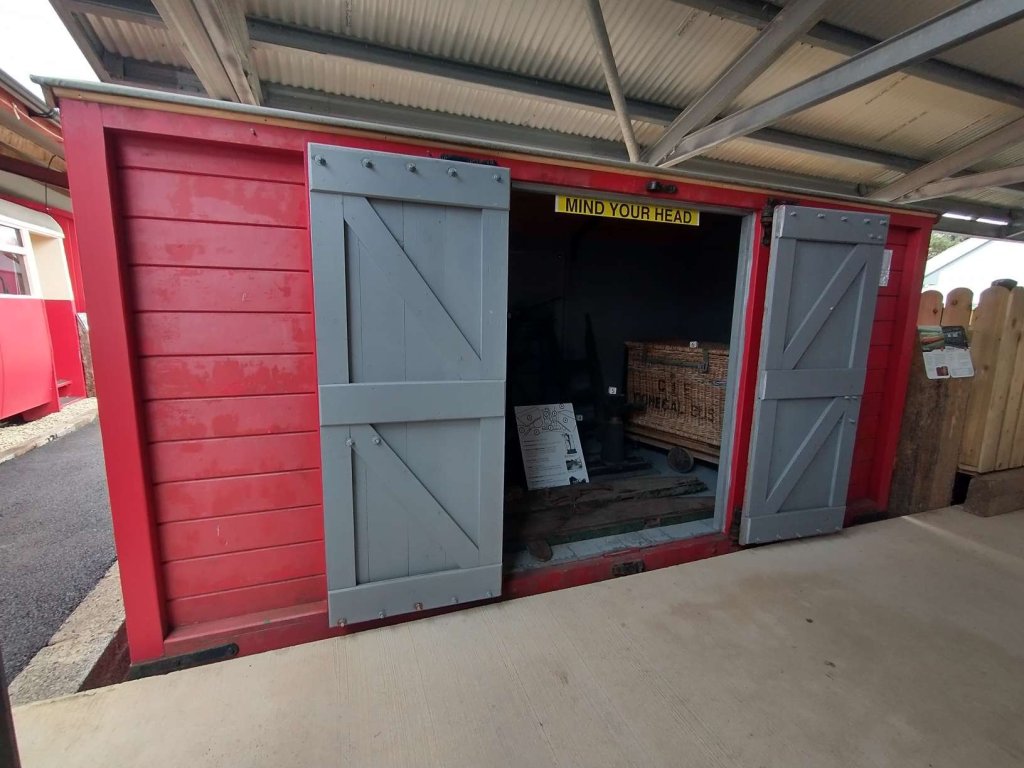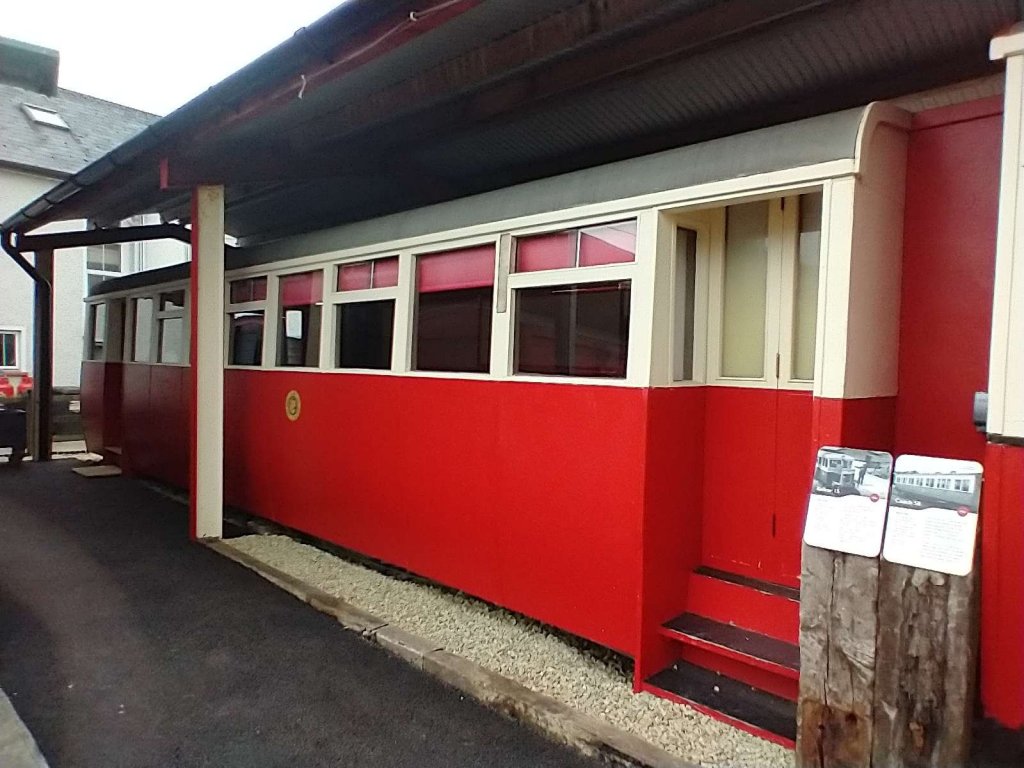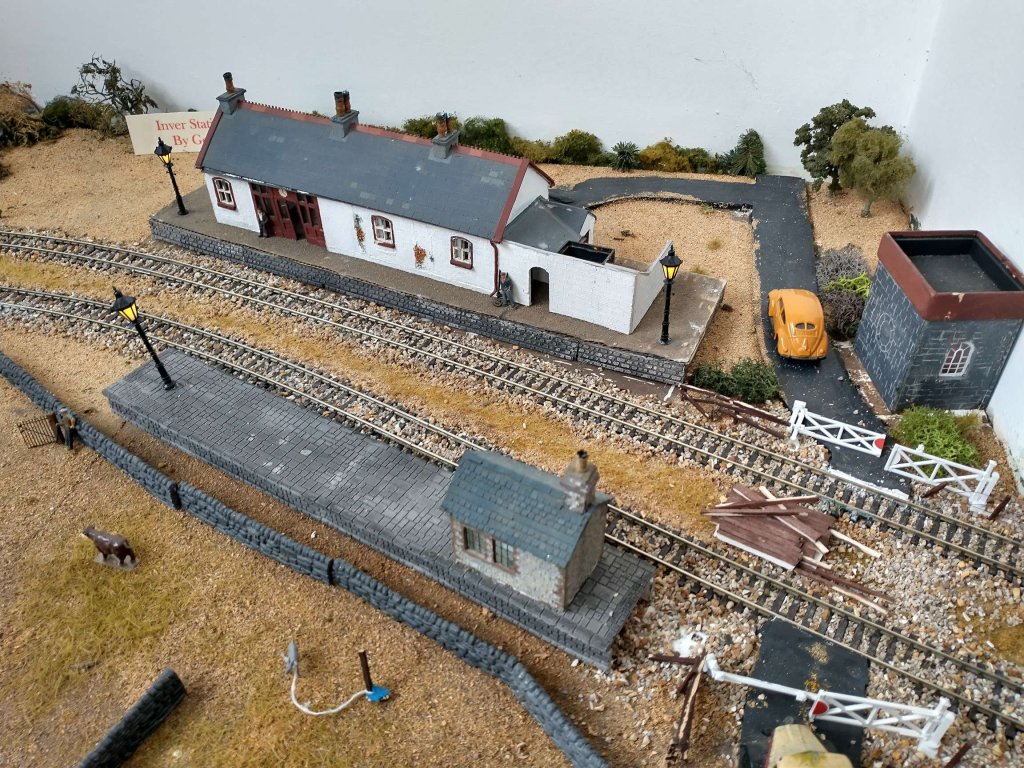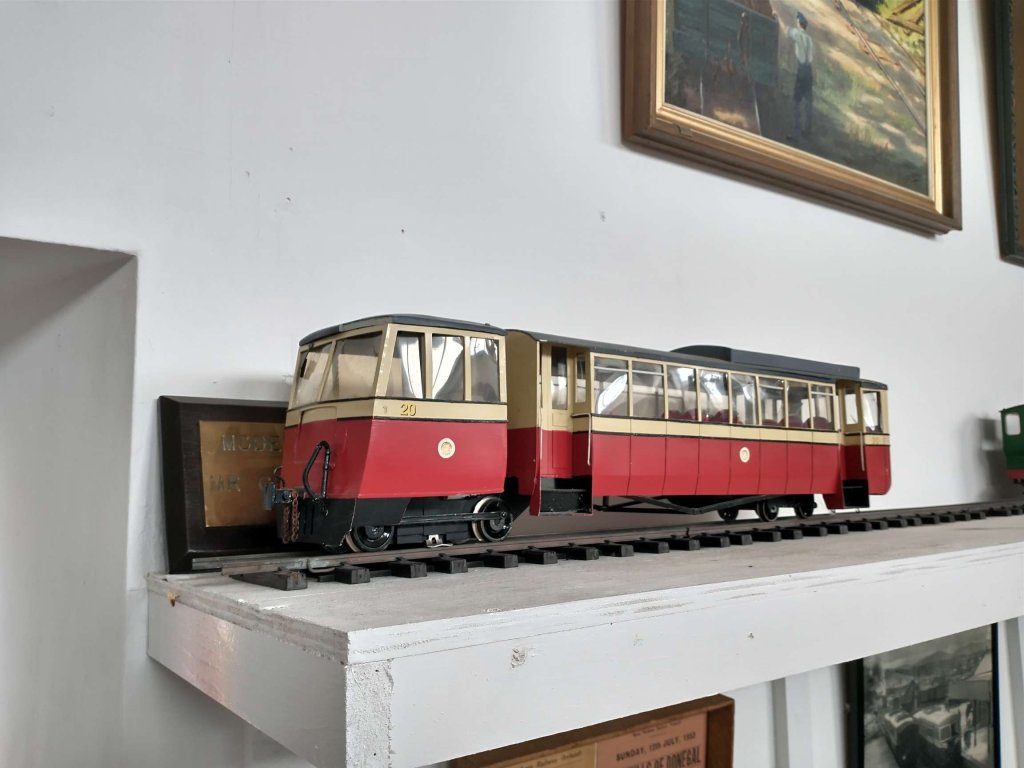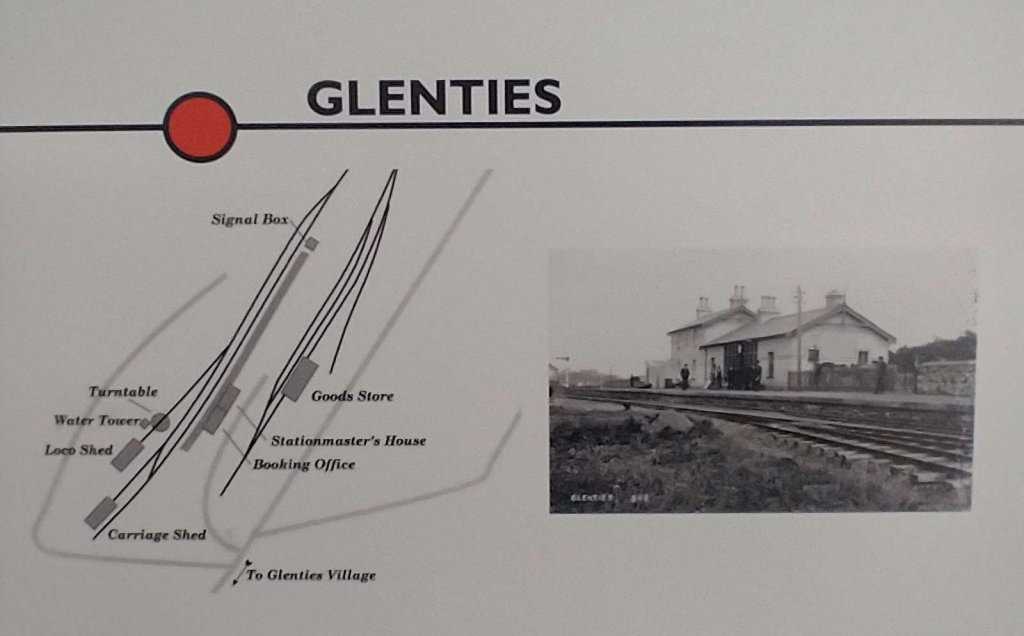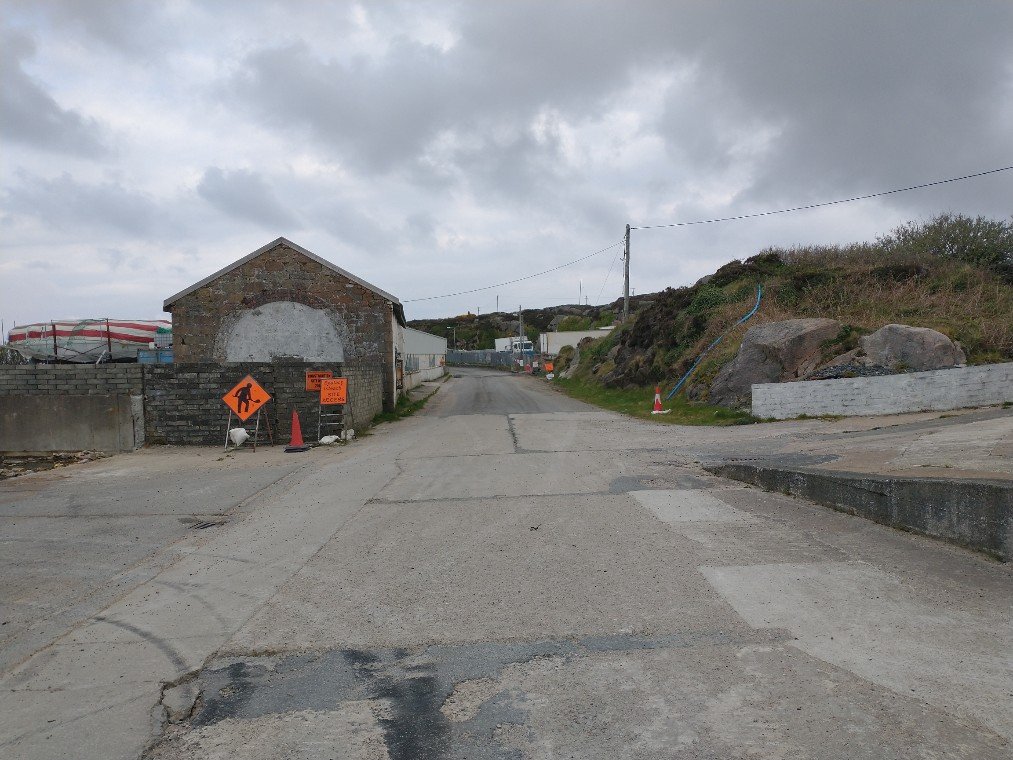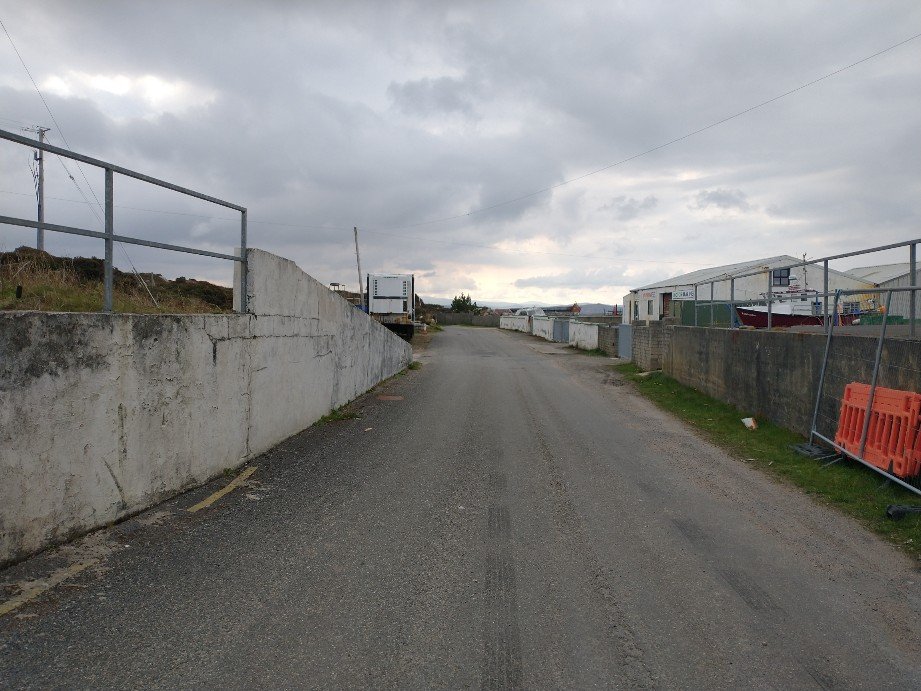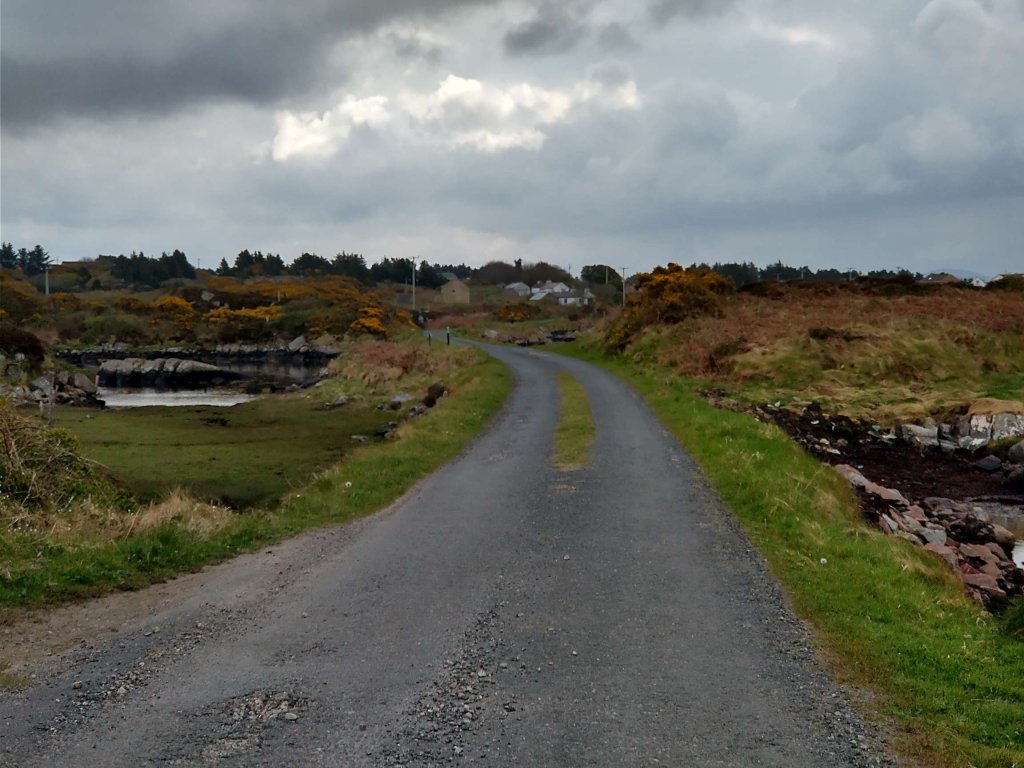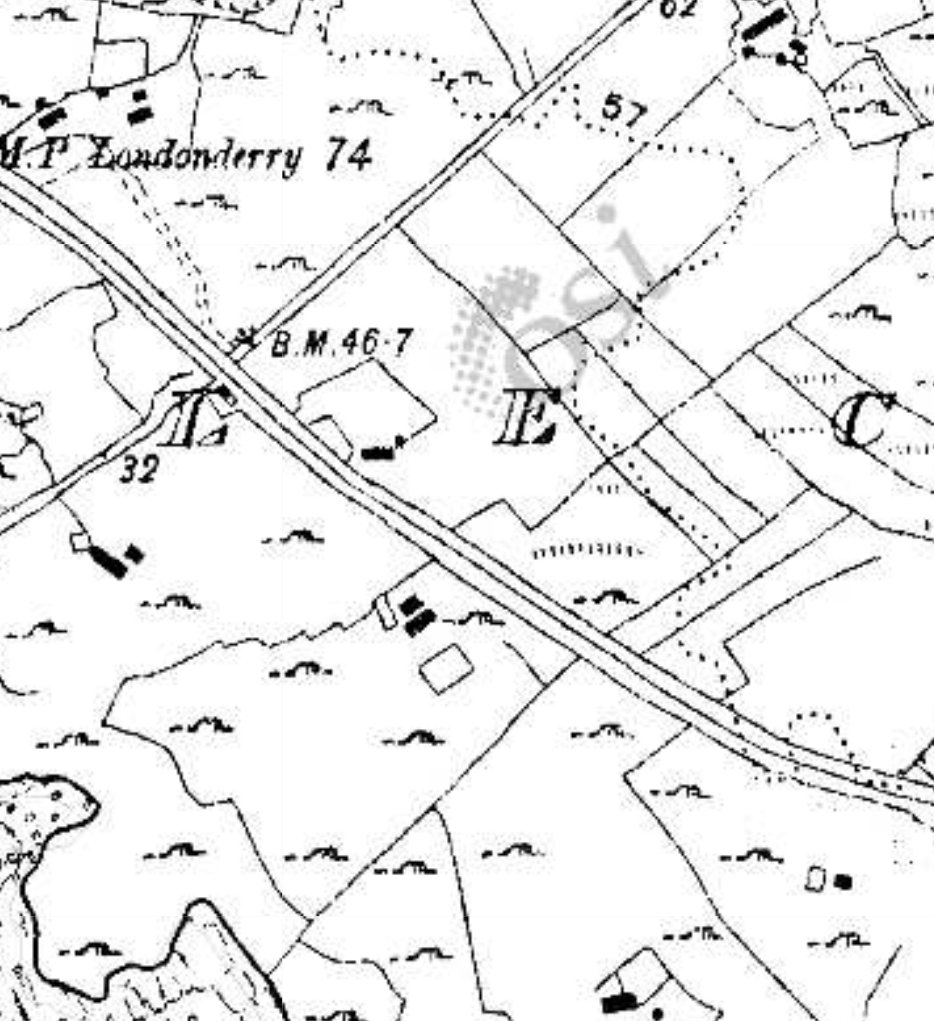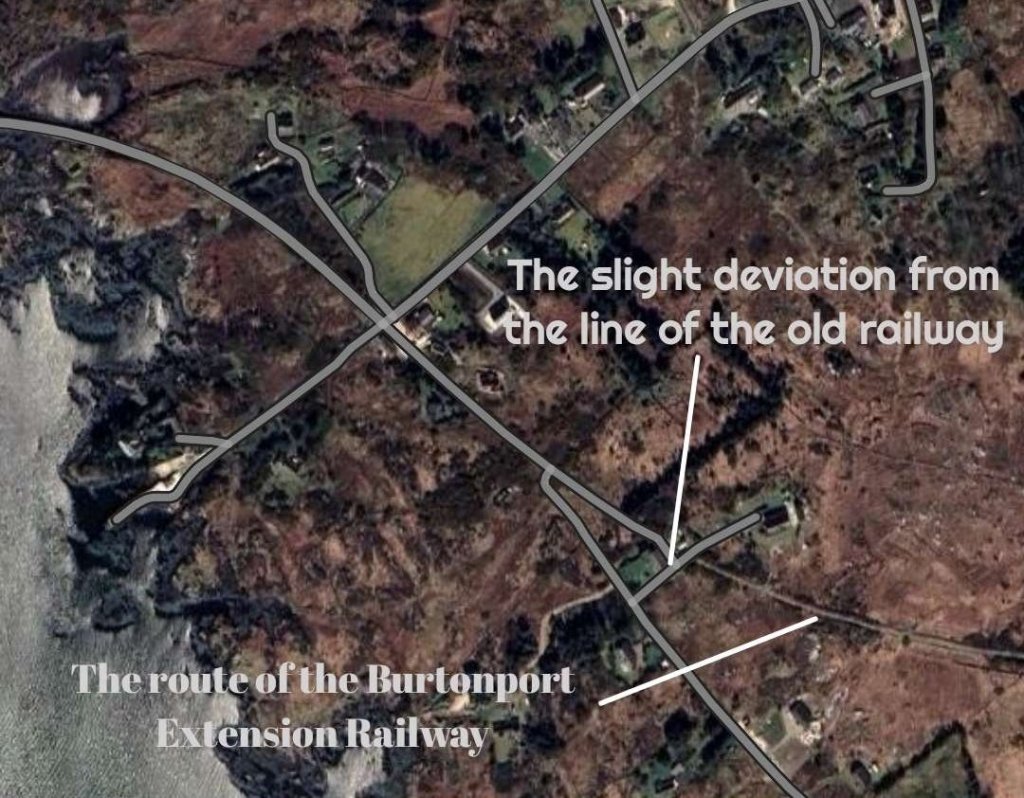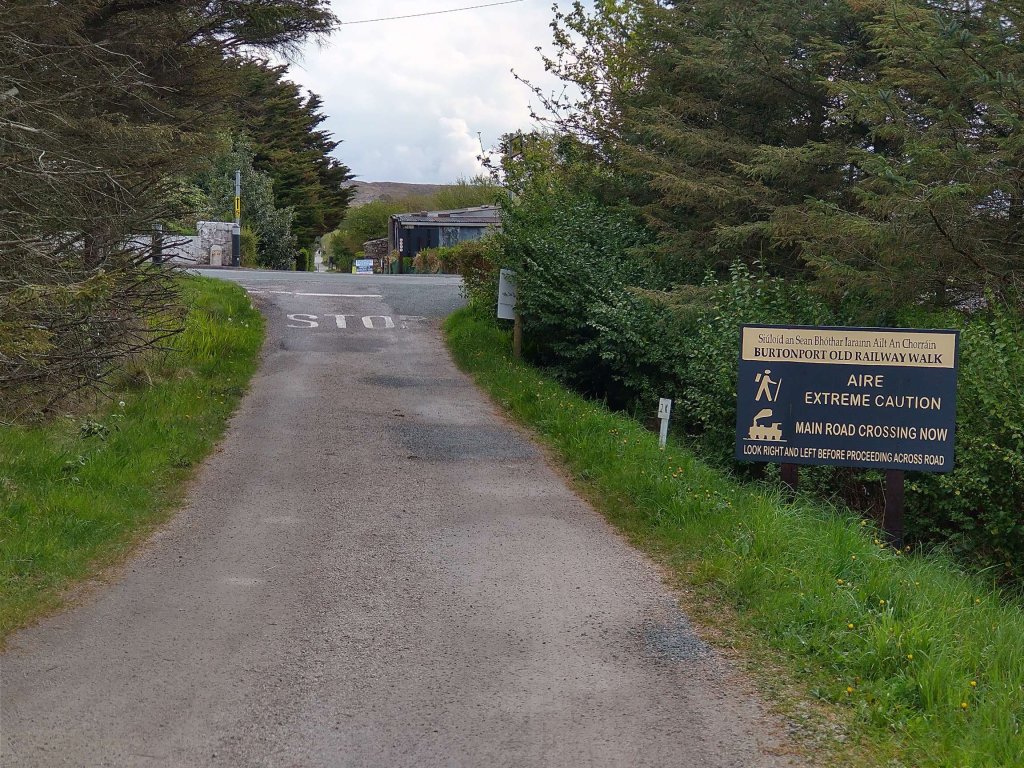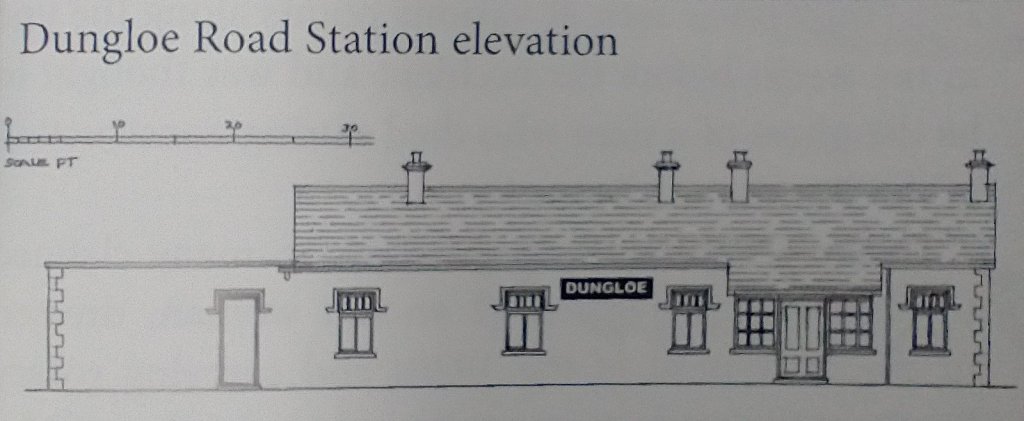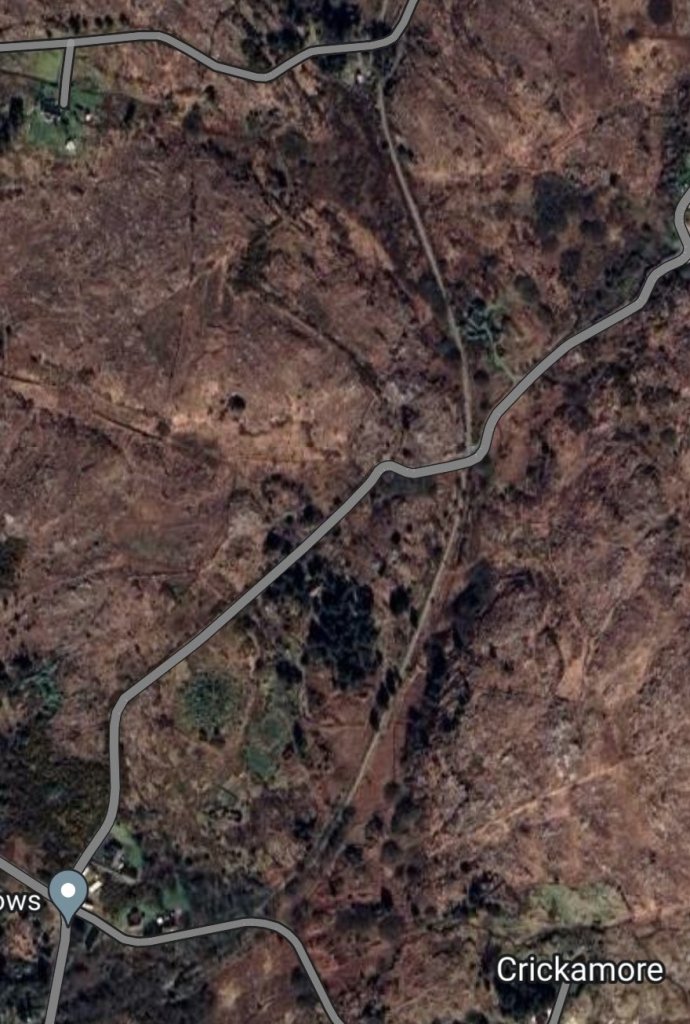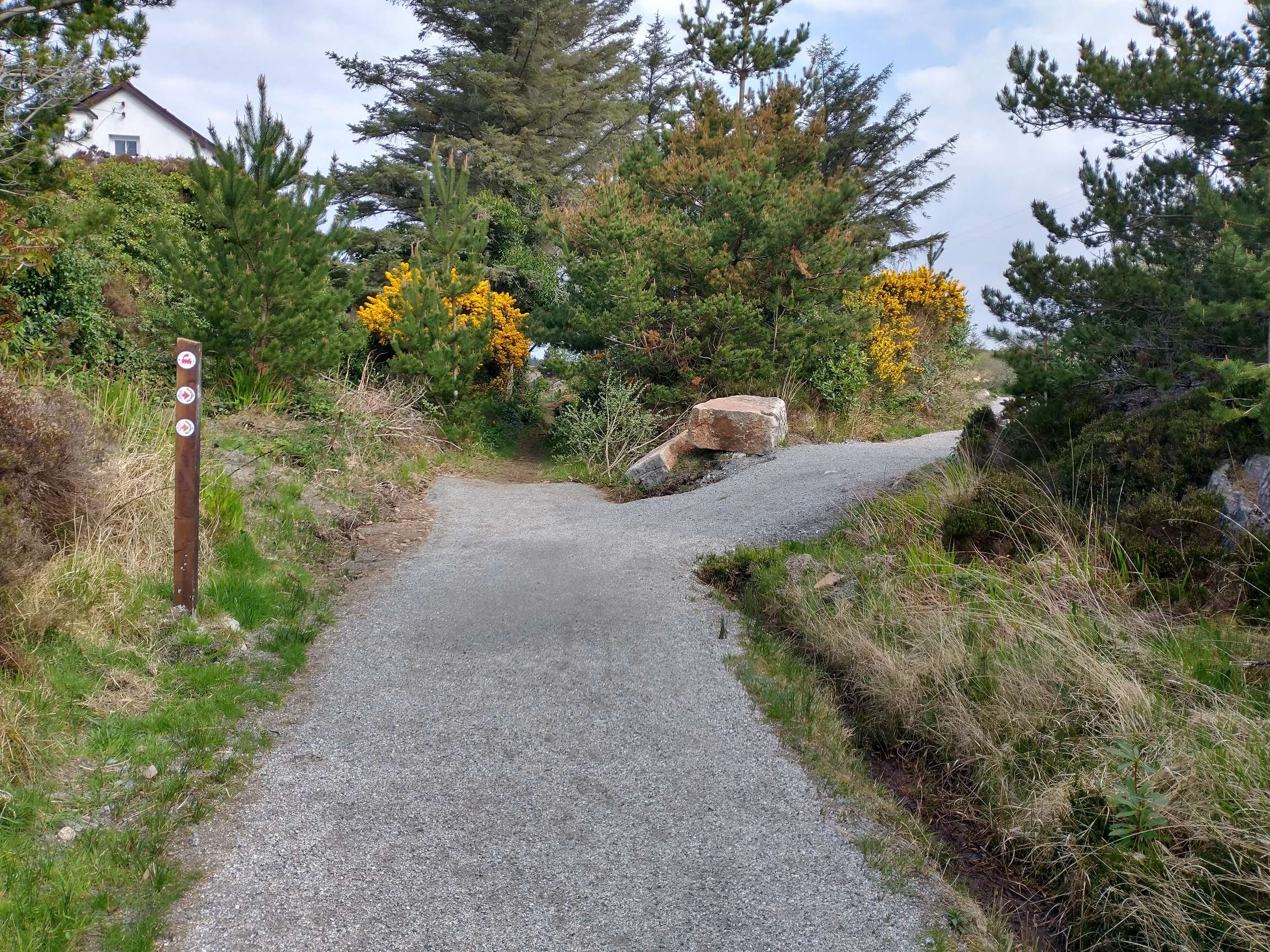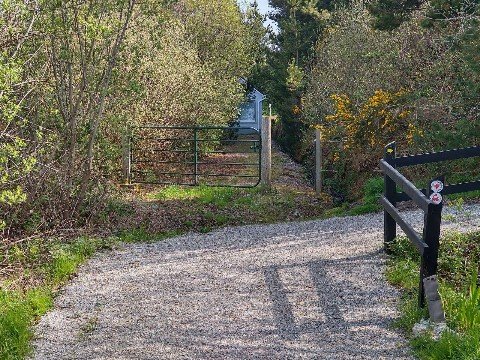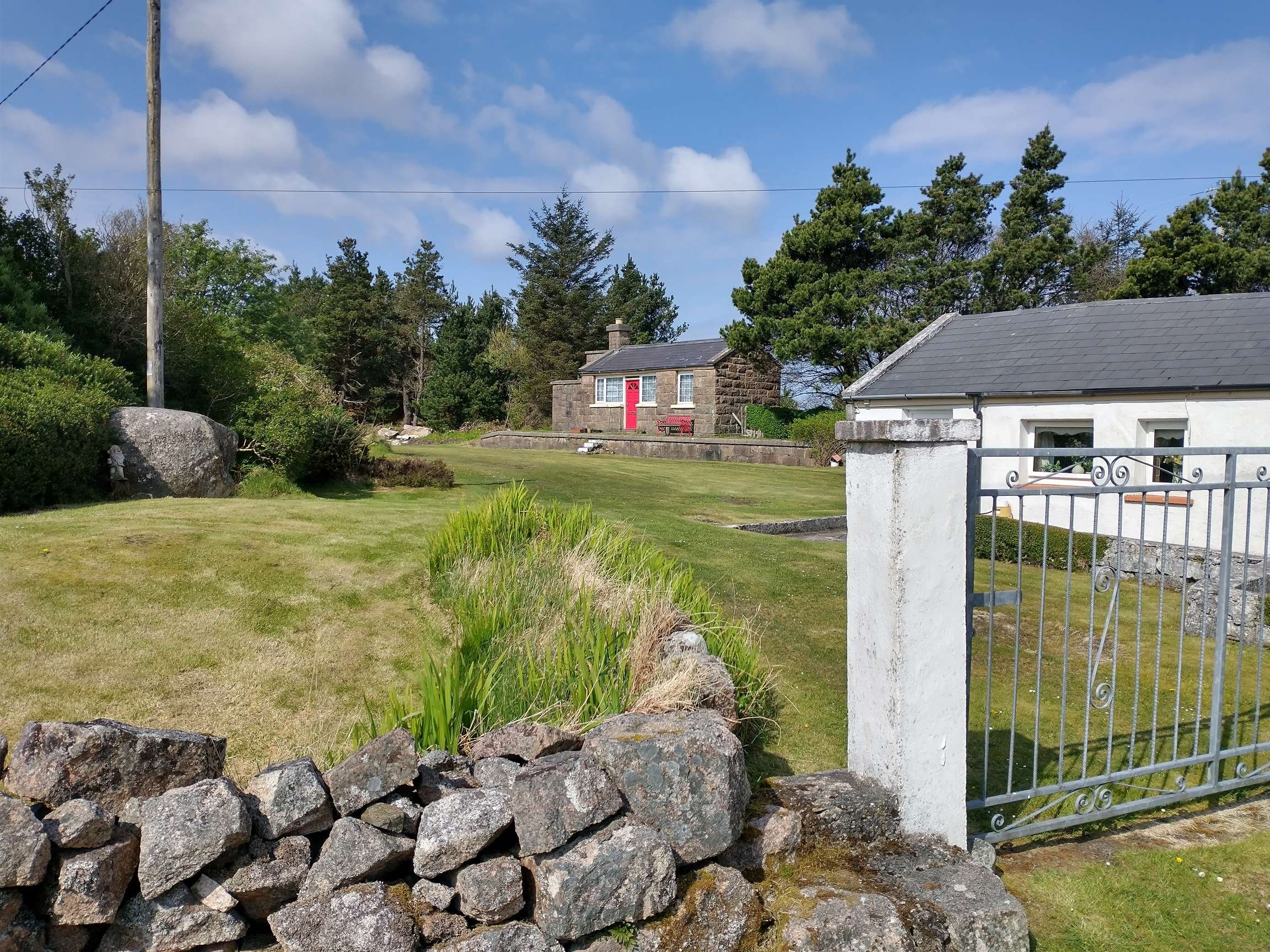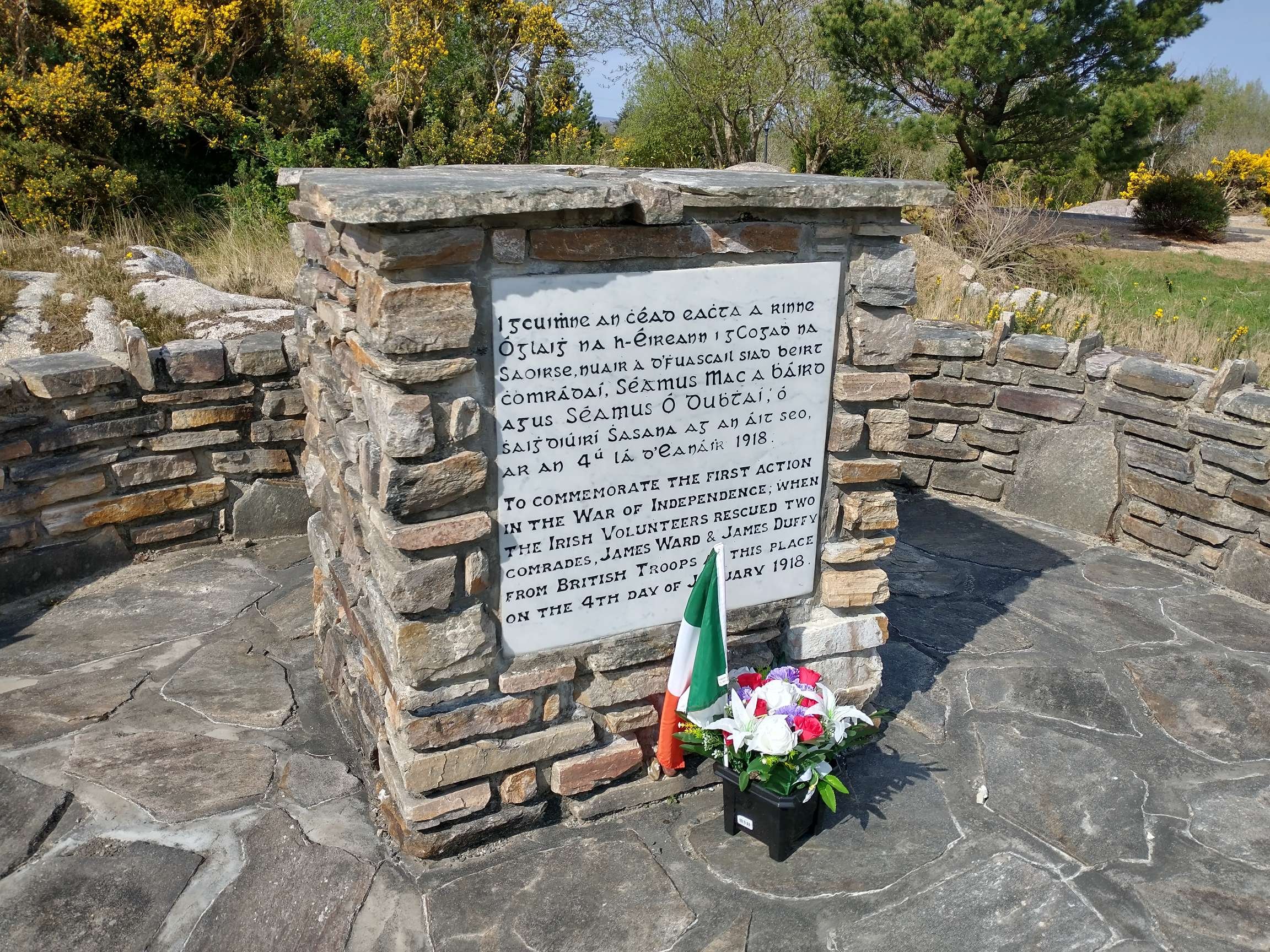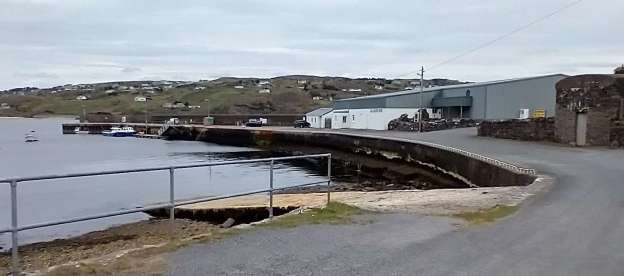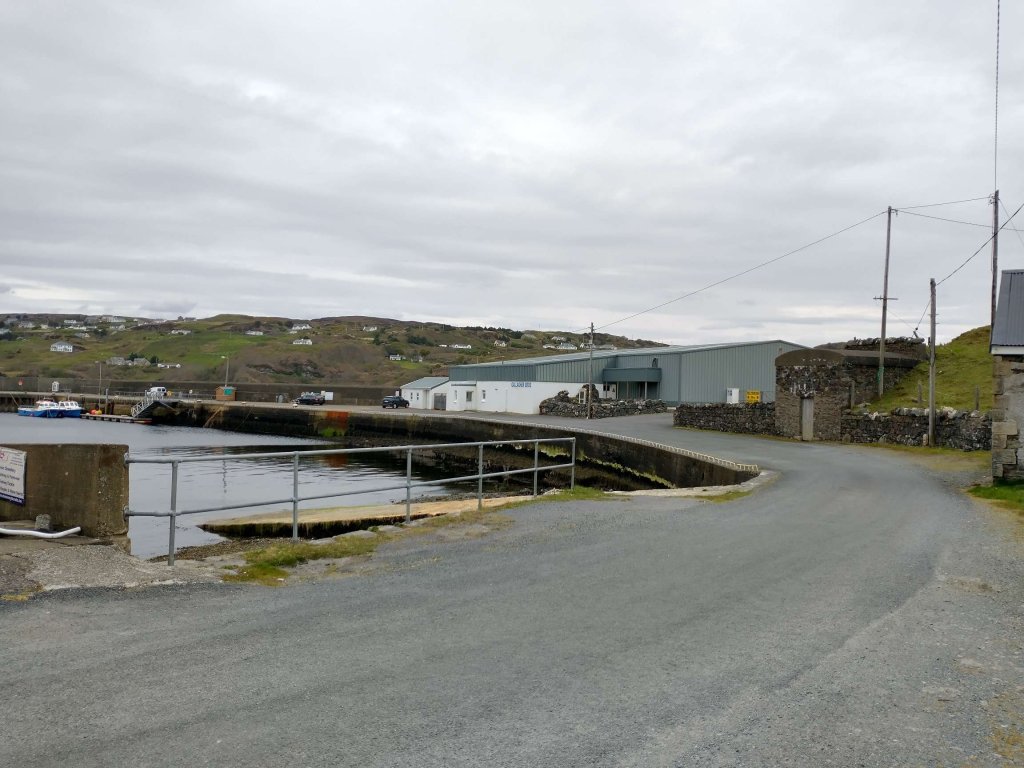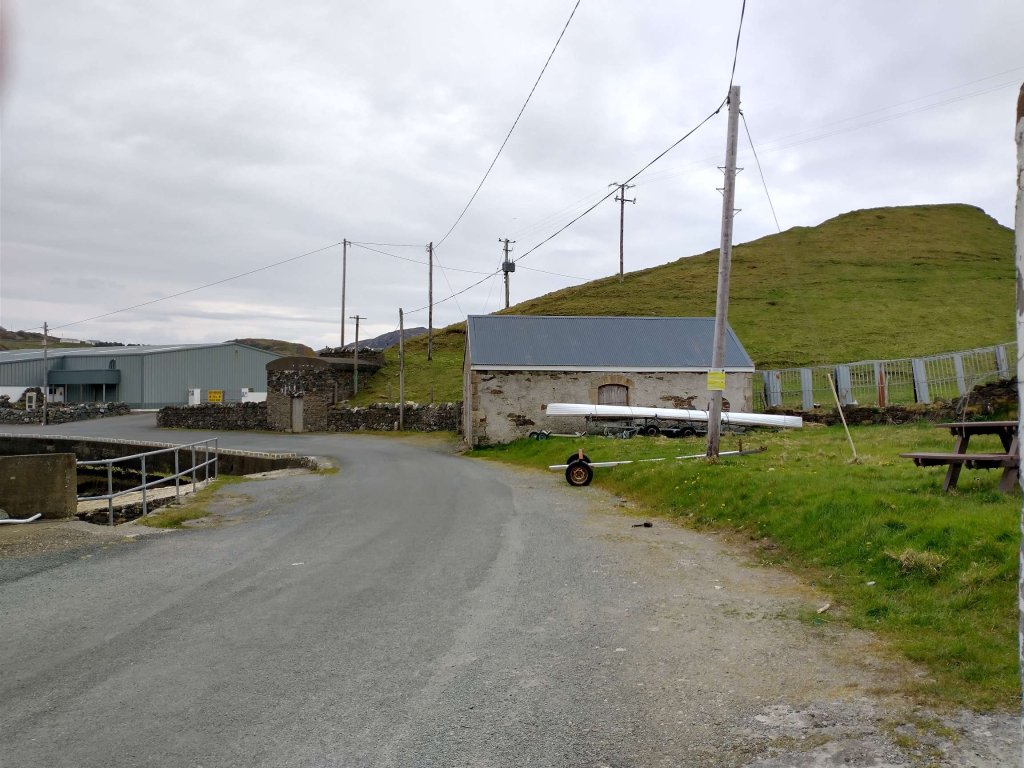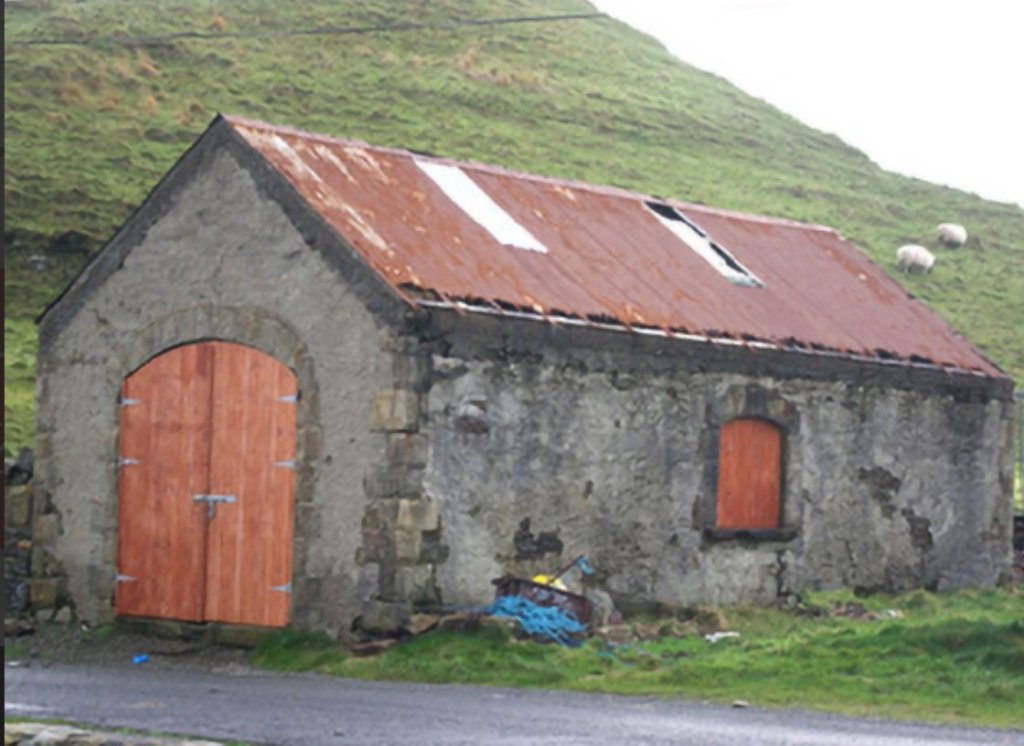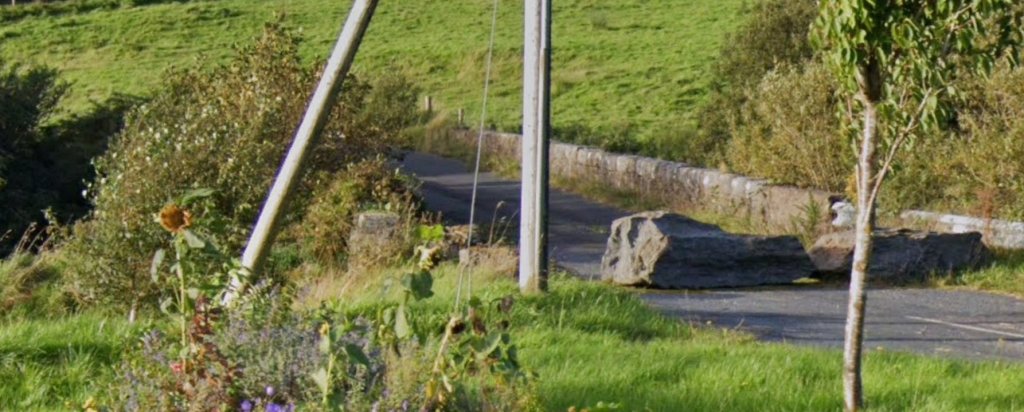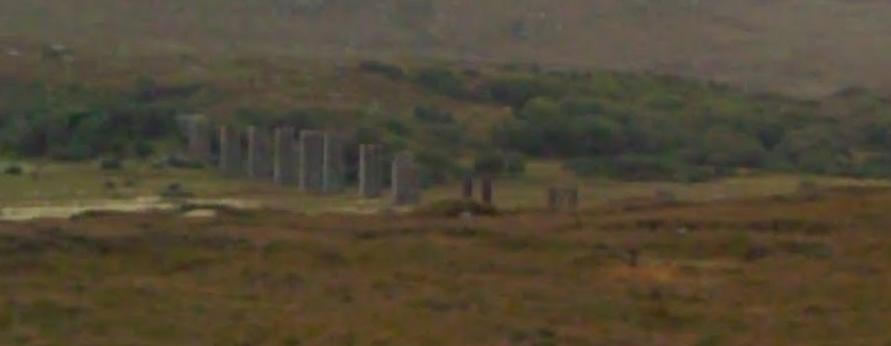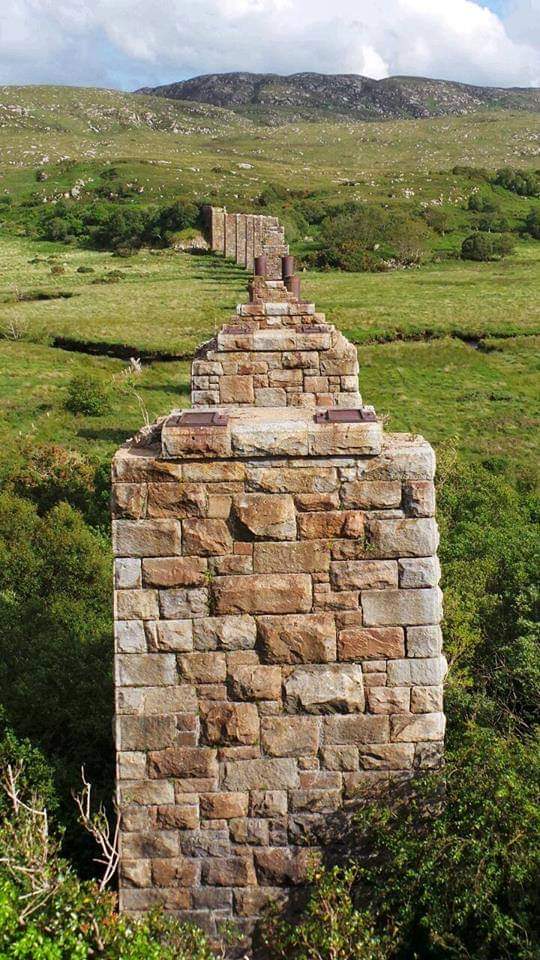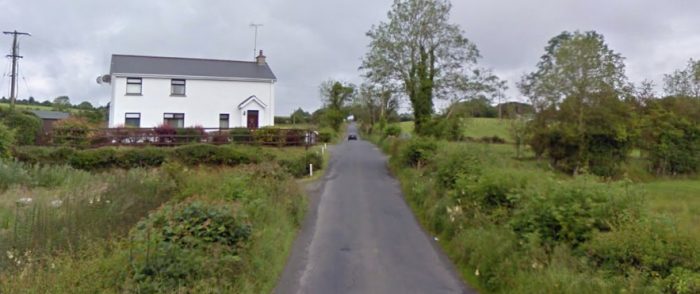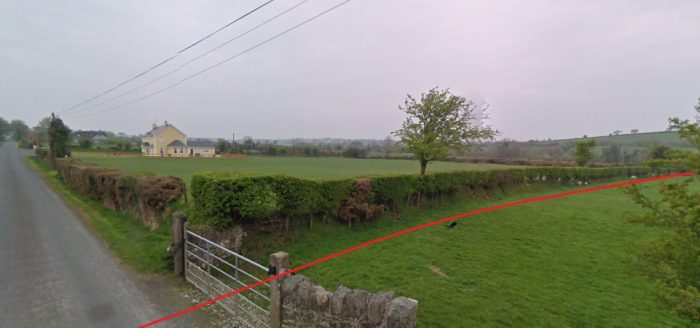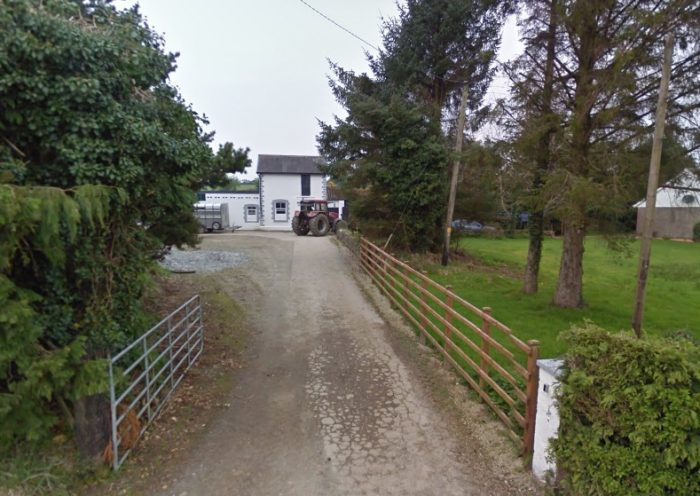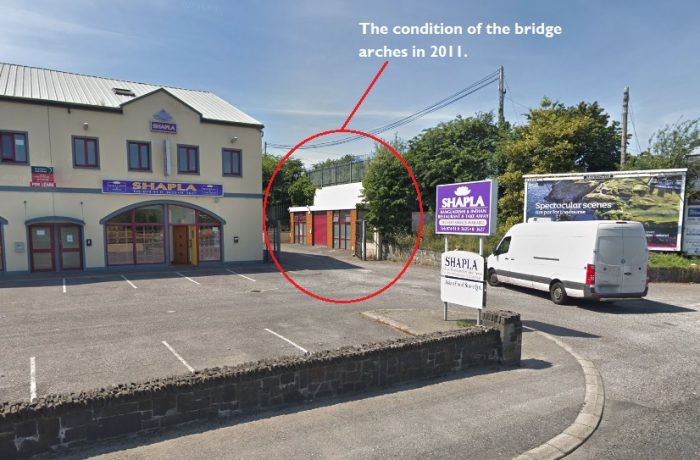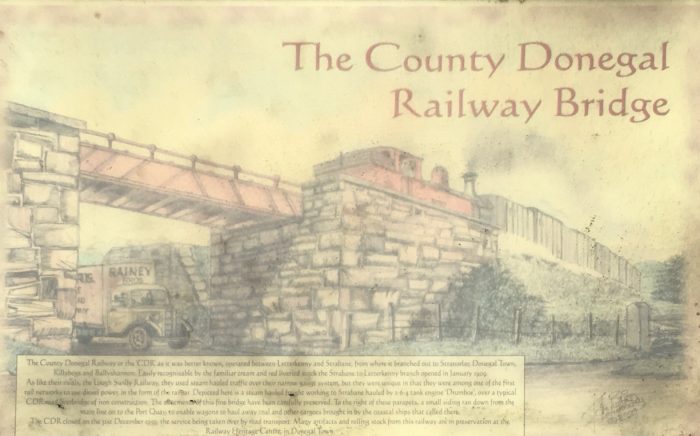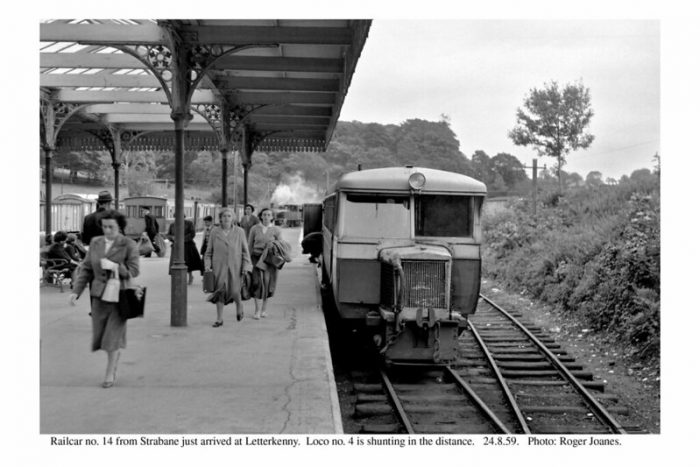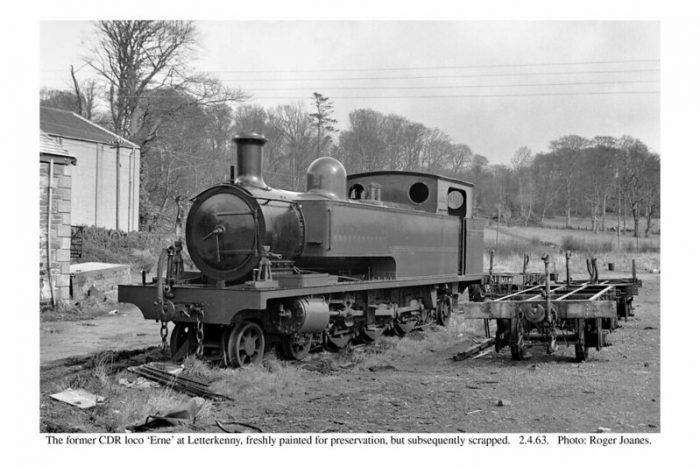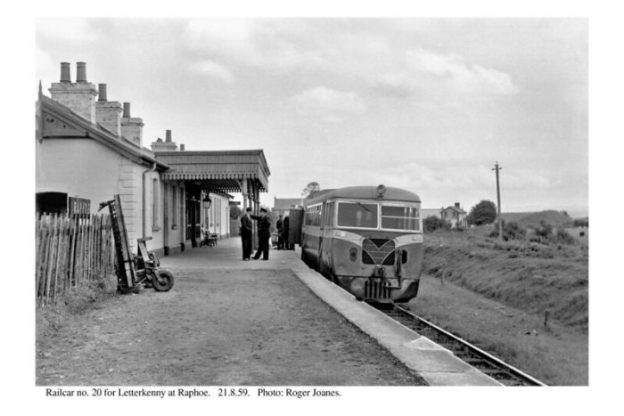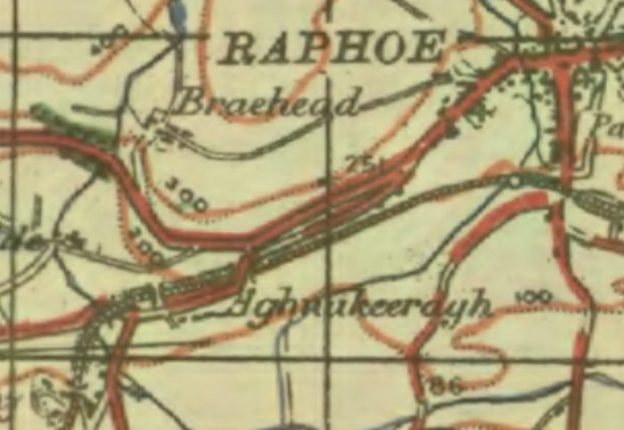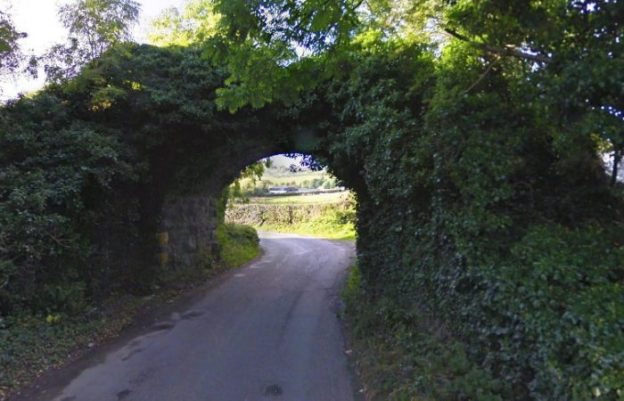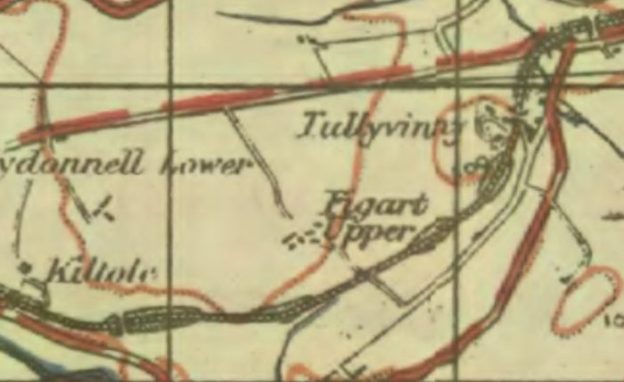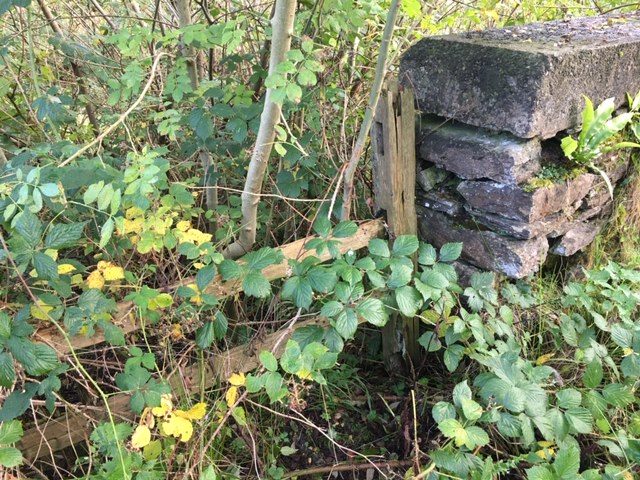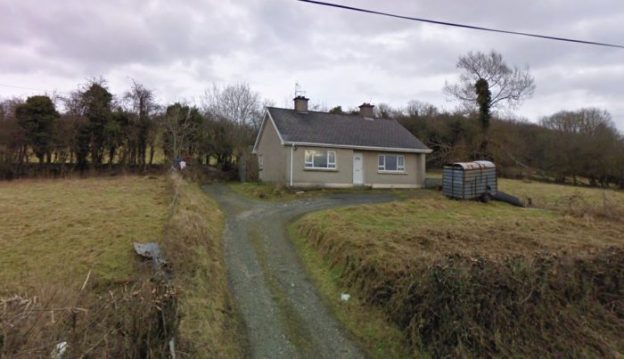As we noted at the start of the two previous articles about this line, Wikipedia gives us a very short history of the line from Strabane to Letterkenny and provides a single image – the Railway Clearing House map with stations in Strabane and Letterkenny:

The Railway Clearing House map with stations in Strabane and Letterkenny. [3]
This series of articles seeks to expand our understanding of the route of the various Co. Donegal Railways through combining old images and modern views. Satellite images also give us a good understanding of what remains of the infrastructure of these lines.
The previous articles about this line which cover the length from Strabane to Convoy can be found by following these links:
Co. Donegal Railways, Ireland – Part 4 – Strabane to Letterkenny (Part A – Strabane to Raphoe)
Co. Donegal Railways, Ireland – Part 5 – Strabane to Letterkenny (Part B – Raphoe to Convoy)
A Journey Along the Line – Strabane to Letterkenny – Part C – Convoy to Letterkenny
We return to Convoy Railway Station which sits to the East of the Village. While we are waiting for our train, a railcar from Letterkenny stops at the station.
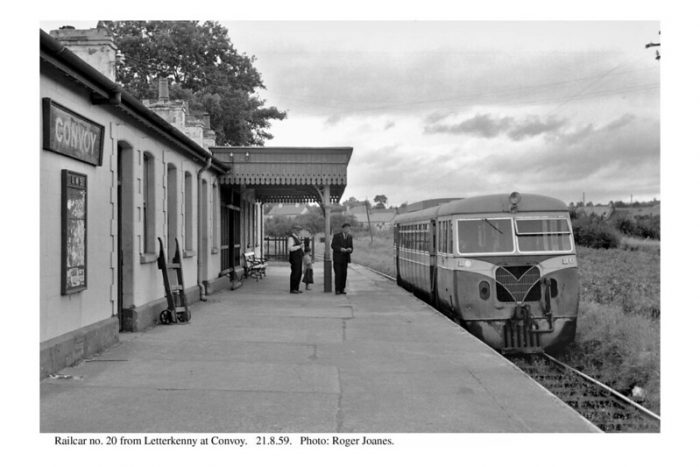
Convoy Railway Station in 1959 (c) Roger Joanes, (CC BY-NC-ND 2.0) Railcar No. 20 from Letterkenny stops at Convoy. [14]
I have found two further pictures of Convoy Railway Station and its site in Anthony Burges’ book, ‘The Swilly and The Wee Donegal’. Both of these photos were taken in 1957 and were either taken by the author or are from his collection. [8: p34 and 35]
The second photograph [8: p35] shows the goods shed, water tower and a number of sidings, but only the goods shed was standing in 2010 when Google Streetview cameras visited the site.

Convoy Railway Station Goods Shed is shown to the right of center in this image taken in 2010 (Google Streetview).
The line out of Convoy Railway station travelling to the West crossed the R236 at a shallow angle protected by Crossing Gates. The Crossing keeper’s cottage (or Gatehouse) is still standing. It has been extended to better be used as a modern family home.
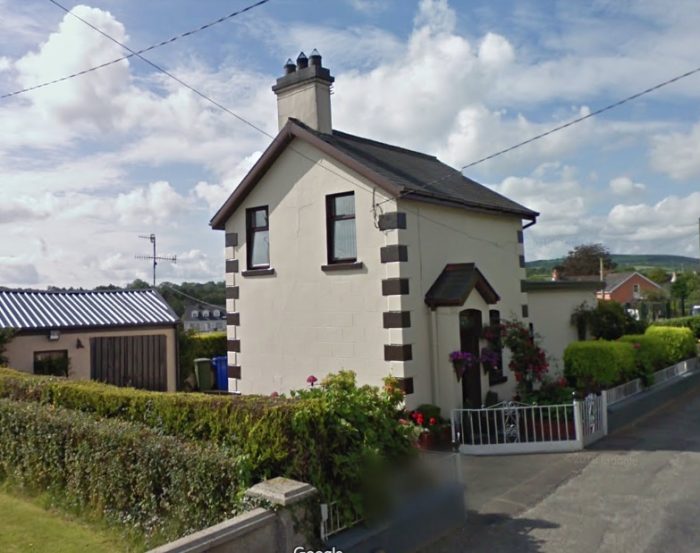
The Gatehouse and the road crossing to the West of Convoy Railway Station. The photograph looks from the Northeast, (Google Streetview).

The Gatehouse guards the route of the old railway which ran just to the right of it in this picture. The image looks from the West back along the old line. (Google Streetview).
The next image shows the centre of Convoy on a Google Maps satellite image. The approximate route of the old railway is shown as a red line running across the image.

The approximate route of the old line through Convoy (Google Maps) The location of the Gatehouse is marked close to the centre of the image. To the West, the line passed under the two bridges which I have numbered 1 and 2 in black type. Clicking on the image will enlarge it sufficiently to allow these locations to be identified easily.
Shortly after crossing the R236, trains passed under the first of two road-over-rail bridges in Convoy. This bridge carried the Letterkenny Road. The railway cutting has been filled-in and there is no evidence of the bridge in the early 21st century.

The old railway cutting has been infilled and to the West of the location of the bridge it is now used as a car park for one of the local churches. It is shown here in 2010, (Google Streetview).

This image is one taken by Kerry Doherty and kindly sent by him to me by email. It shows the same location in the years following the Google Streetview image. [6]
A short distance further along the line a bridge carried a lane heading Northwest from Convoy towards Falmore.

This first view shows the bridge parapet on the East side of the bridge in January 2010 (Google Streetview). The parapet is in a very poor condition.

This later view, a picture taken by Kerry Doherty, shows that some local pride has resulted, more recently in a cosmetic refurbishment of the old parapet. [6]
To the West of the old bridge the cutting is still infilled and no sign of a bridge parapet can be found.

Looking West along the line of the old railway from the road to Falmore in 2010, (Google Streetview).
Heading away from Convoy the line quickly turned to the North as shown on the next satellite image. It soon crossed the road to Falmore once again, this time at level. The Gatehouse for this road-crossing is indicated on the satellite image and can be seen in the Google Streetview image which follows.

The old line to the West of Convoy, (Google Maps).

Kelly’s Gatehouse on the road to Falmore. The line ran to the right of the cottage in this image, (Google Streetview).
The line now heads in a northerly direction as the satellite images show.

The first length to the North of the Gatehouse on the road between Convoy and Falmore, (Google Maps).

The second length north of the road, (Google Maps).

The line continued in a northerly direction passing over the Cloghcore to Cornagilagh road, (Google Maps).
Further North, the line crossed the road from Cloghcore to Cornagilagh. Either side of this road, the line was on an embankment which has now been removed but the bridge which carried it over the road is still in place – an elegant small stone arch bridge bears excellent testimony to the route of the old railway. The location of the old bridge is at the point where the line (red) crossed the road (light blue) in the bottom left of the adjacent satellite image.
Photographs of this bridge follow below. Two of which are taken from Google Streetview and one sent to me in an email by Kerry Doherty. The light in his photograph shows the bridge at its best.
Very soon after crossing this bridge, trains entered Cornagillagh Halt which was only a short distance from the hamlet/village which bears the same name.

The rail-over-road bridge on the …. road. This image shows the bridge from the Southwest in March 2011, (Google Streetview).

The same bridge also viewed in March 2011 from the Northeast (Google Streetview).

A much more recent picture taken of the same bridge by Kerry Doherty. [6] Kerry comments: ‘The over bridge just before Cornagillagh halt. The embankment at either side has been taken away but the bridge has been kept..’
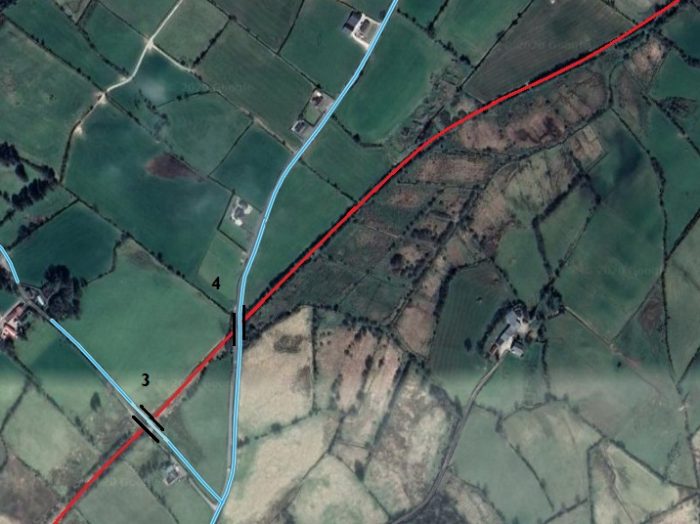
The next length of the old line is featured in this satellite image which shows it passing in cutting under two road bridges marked ‘3’ and ‘4’ either side of and close to Cornagillagh Halt, (Google Maps).
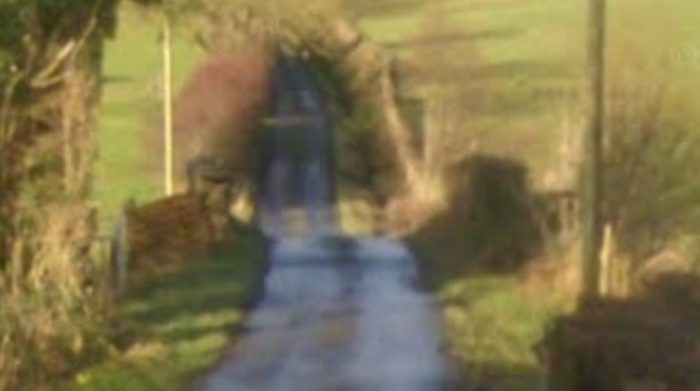
The road-over-rail bridge close to Cornagillagh Halt is marked on the Google Maps image as No. ‘3’. The vertical alignment of the road gives away the bridge location. The image is a telephoto lens view because of a slight glitch in the Google Streetview image sequence close to the bridge location. This picture was taken from the Southeast in December 2009 in what looks like late afternoon sunshine, (Google Streetview).  This image shows the same bridge (No. ‘3’) from the Northwest just a few weeks after the image which precedes it. The road alignment changes at the bridge and on this image it is easier to see the bridge parapets,(Google Streetview).
This image shows the same bridge (No. ‘3’) from the Northwest just a few weeks after the image which precedes it. The road alignment changes at the bridge and on this image it is easier to see the bridge parapets,(Google Streetview).
The next few photographs come from the location of the road-over-rail bridge that I have marked ‘4’ on the satellite image. All of them were taken as part of Google’s survey in March 2011.

Bridge numbered ‘4’ viewed looking North along the road, (Google Streetview)
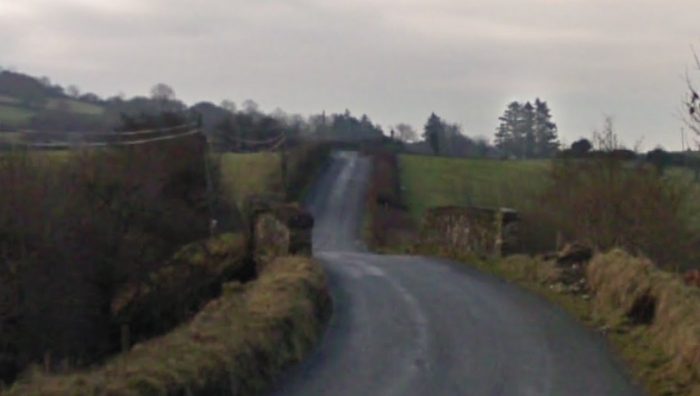
Then same bridge but viewed from the North on the same day, (Google Streetview).

This picture shows the formation of the old railway between the bridge numbered ‘3’ by me and bridge ‘4’, (Google Streetview).

Looking to the Northeast, the formation of the Strabane and Letterkenny Railway has been overtaken by small trees and shrubs. (Google Streetview).

Kerry Doherty comments that this is a view of the bridge close to the site of Cornagillagh Halt (now impossible to photograph as its so overgrown). Pictured is former railcar driver Michael Gallen (recently dec’d, and one of the very last railcar drivers). The picture comes was taken by Dave Bell and comes from the CDR visitors guide book. [6][4]
The old railway route begins to turn North again soon after passing under the road-bridge and heads for
Glenmaquin (Glerundorum) station.

Beyond the road-bridge the old formation turns to the North once again, (Google Maps).

The line South of Gerundoram Railway Station. The location of the station can still be picked out at the top of this satellite image, (Google Maps).
The adjacent satellite image shows the route of the old line to the South of Glenmaquin (Glerundorum) Station. The first location to note is the at-level crossing of a local road towards the bottom of the image. The gatehouse can be picked out just to the West of the route of the old line.
The Gatehouse (N0. 57) has been extended to make it suitable as a small modern dwelling. and pictures from Google Streetview show it in really good condition with well-tended gardens.
The line shows up as a tree-lined track crossing the road at this point. The third image below is the closest that Google Streetview gets to providing a view along the length of the line North of the Level-Crossing towards Glenmaquin Railway Station.
A short distance further North trains entered Glenmaquin (Glerundorum) Station, shown here on the old GSGS mapping from the 1940s. … Glenmaquin (Glerundorum) Station was location close to a road junction and was framed by a road-over-rail bridge to its Northwest. [2]
Glenmaquin (Glerundorum) Station was location close to a road junction and was framed by a road-over-rail bridge to its Northwest. [2]
Kerry Doherty has kindly provided a view across the old station site which was taken in the early 21st century.

The old station site taken from the fields to the Northwest, (c) Kerry Doherty. [6] The old platform is still clearly visible in this photograph.
Google Streetview shows that the space between the railway station and the road-over bridge is, in the 21st century, filled by a modern home. That property sits just out of view to the left of Kerry Doherty’s picture above.
 Glenmaquin Station, (Google Streetview).
Glenmaquin Station, (Google Streetview). The road bridge just North of the Station, (Google Streetview).
The road bridge just North of the Station, (Google Streetview). A much earlier view of Glenmaquin Railway Station which comes from the Dave Bell collection, taken from the CDR visitors guide book. Kerry Doherty’. [6]
A much earlier view of Glenmaquin Railway Station which comes from the Dave Bell collection, taken from the CDR visitors guide book. Kerry Doherty’. [6]
The continues in cutting North of the road bridge at Glenmaquin Station. Cutting to the North of Glenmaquin Station. This photograph was taken from the road bridge, (c) Kerry Doherty. [6] Just out of sight the railway bridged a small river.
Cutting to the North of Glenmaquin Station. This photograph was taken from the road bridge, (c) Kerry Doherty. [6] Just out of sight the railway bridged a small river.
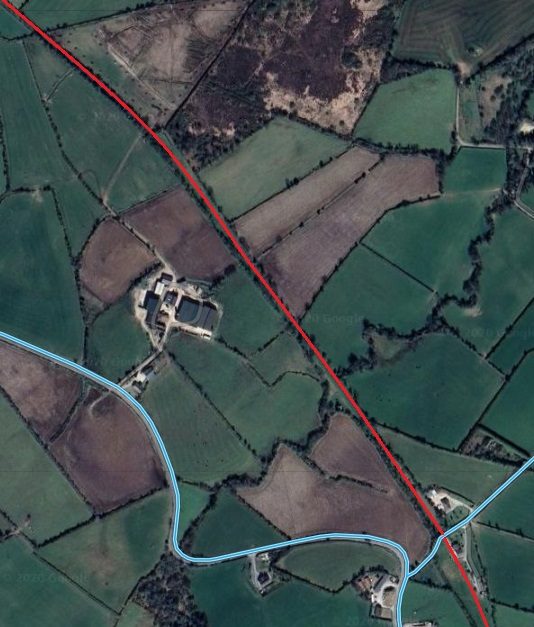
Beyond Glemaquin Station, the old line continued heading Northwest, (Google Maps).

After crossing another minor road the old track-bed curved round towards the Northeast, (Google Maps).
The road crossing visible at the bottom right of the satellite image immediately above was un-gated. A closer image o the crossing location is provided immediately below this text. The Google Streetview images here show an extended property based on a typical Gate-keeper’s Cottage. This location is not recorded in the Visitor’s Guide {4} as a Crossing with Gatehouse. Interestingly the cottage is sited out of alignment with the railway as the satellite image below shows. Un-gated Crossing Northwest of Glenmaquin Railway Station, (Google Maps)
Un-gated Crossing Northwest of Glenmaquin Railway Station, (Google Maps)
These next few images are taken at the location above – all are from Google Streetview. This may well be the location of Gatehouse No. 58.
We noted in the satellite images above that, to the Northwest of the road crossing, the old line turn round to the Northeast. The next length of the line as shown on the GSGS mapping from the 1940s. [7]
The next length of the line as shown on the GSGS mapping from the 1940s. [7]
 We pick it up again in the next satellite image on the left. The track follows a sinuous course over the next kilometre or so, as can be seen on the next satellite image below.
We pick it up again in the next satellite image on the left. The track follows a sinuous course over the next kilometre or so, as can be seen on the next satellite image below.

These two image show the line passing under the road from Listillion to Lyons Court and then crossing the road between Listillion and Drumerdagh at Gatehouse No. 59. Kerry Doherty comments that the first of these two locations is a “bridge now filled in and the road re-aligned.”
Doherty provides two photographs from that location: 

At this location the old road has been realigned when the bridge over the railway cutting was filled in. Both photographs were taken by Kerry Doherty, (c) Kerry Doherty [6]

A close-up Satellite image shows the old road alignment across the bridge. ….
The next feature along the line is Gatehouse No. 59 which is shown on the second of the two adjacent satellite images above.

Another extract from the GSGS Maps of the 1940s shows the length of the old line to the South of Gatehouse 59. [9]

Gatehouse 59 is at the bottom of this enlarged extract from Google’s satellite imagery, (Google Maps).
Beyond the infilled road bridge, the formation of the old line snaked northwards before reaching Gatehouse 59. Both the GSGS map and the satellite image above show that route. Gatehouse 59. The adjacent enlarged satellite image shows the location of Gatehouse 59 just to the North of the road at the bottom of the image.
The first Streetview image below shows the Gatehouse from the South. It is followed by a short series of views mainly from Google Streetview of the same Gatehouse. One image was generously provided by Kerry Doherty.
As the adjacent satellite image shows the old railway continued North from the location of Gatehouse No. 59. A modern bungalow and farm building straddles the old line and before it runs at the back of the gardens of a further two properties.
The first satellite image below show the route of the old railway as it begins to approach Letterkenny. After continuing North for a short distance the line turned sharply to the West running to the South side of what is today the N13/N14 dual carriageway and the L1114 local road.

The Strabane and Letterkenny Railway turned sharply to the left a short distance beyond Gatehouse No. 59, (Google Maps). The route is highlighted by a linear woodland which appears once the buildings close to the Gatehouse have been passed.
The old line was initially on a small embankment to the North of Gatehouse No. 59, but by the time it stared to curve to the West is was in cutting. Its route is now a linear woodland, as the satellite image above shows. I am really grateful to Kerry Doherty who visited this location on my behalf in October 2020. The next few images are taken by him. This picture is taken from the old track-bed looking towards the bridge, (c) Kerry Doherty. [6] The old formation can be seen curving to the left in this image. This is one of the more substantial structures along the length of the Strabane to Letterkenny Railway.
This picture is taken from the old track-bed looking towards the bridge, (c) Kerry Doherty. [6] The old formation can be seen curving to the left in this image. This is one of the more substantial structures along the length of the Strabane to Letterkenny Railway. Looking back to the South from the 3-arch Bridge, (c) Kerry Doherty. [6]
Looking back to the South from the 3-arch Bridge, (c) Kerry Doherty. [6]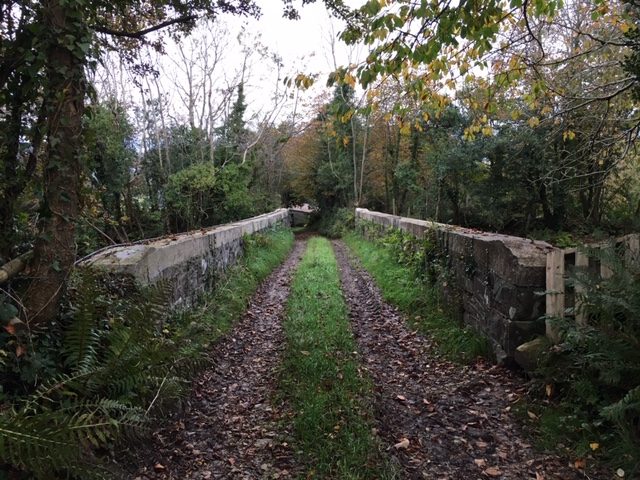 The substantial stone parapets belie the use of the over bridge which carries no more thana local track, (c) Kerry Doherty. [6]
The substantial stone parapets belie the use of the over bridge which carries no more thana local track, (c) Kerry Doherty. [6] Looking ahead towards Letterkenny from the track carried by the old bridge, (c) Kerry Doherty. [6]
Looking ahead towards Letterkenny from the track carried by the old bridge, (c) Kerry Doherty. [6] Looking back towards the bridge from the old railway formation, (c) Kerry Doherty. [6]
Looking back towards the bridge from the old railway formation, (c) Kerry Doherty. [6] The structure still retains its old number – 279! (c) Kerry Doherty. [6]
The structure still retains its old number – 279! (c) Kerry Doherty. [6]
Beyond structure No. 279 the old railway continued to curve round to a westerly direction and still in cutting encountered another road over rail bridge. The location of that bridge is to the right of the satellite image below. The Eastern outskirts of Letterkenny with the route of the Strabane & Letterkenny Railway highlighted in red, (Google Maps).
The Eastern outskirts of Letterkenny with the route of the Strabane & Letterkenny Railway highlighted in red, (Google Maps).
The cutting at the Eastern side of the satellite image above has been partially infilled but the old bridge still has a void underneath it. Although the bridge is clearly of an age commensurate with having been built at the same time as the line, it does not appear on the 1940s GSGS map below. GSGS 1940s Map of the Strabane and Letterkenny Railway on its early approaches to Letterkenny. At the western extremity of the map extract the point where the line begins to run immediately parallel to the Londonderry & Lough Swilly Railway can just be seen. [10]
GSGS 1940s Map of the Strabane and Letterkenny Railway on its early approaches to Letterkenny. At the western extremity of the map extract the point where the line begins to run immediately parallel to the Londonderry & Lough Swilly Railway can just be seen. [10]
Kerry Doherty commented that the filling of the cutting seems to have cut off drainage runs and as a result there is a small body of water in the cutting. This does not show up on the pictures below.

The old railway cutting with the bridge just visible in the distance (Google Streetview)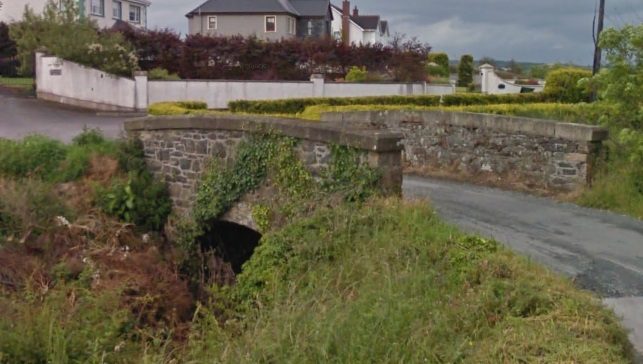 The bridge. This Google image shows the void underneath the structure. It is taken from the road which runs alongside the cutting (on its North side) for a short distance, (Google Streetview)
The bridge. This Google image shows the void underneath the structure. It is taken from the road which runs alongside the cutting (on its North side) for a short distance, (Google Streetview) This is Kerry Doherty’s photo of the bridge taken from the South side of the railway cutting in October 2020, (c) Kerry Doherty. [6]
This is Kerry Doherty’s photo of the bridge taken from the South side of the railway cutting in October 2020, (c) Kerry Doherty. [6] This view shows the overgrown cutting looking back towards Strabane from the bridge above, (c) Kerry Doherty. [6]
This view shows the overgrown cutting looking back towards Strabane from the bridge above, (c) Kerry Doherty. [6] Finally at this location, another of Kerry Doherty’s photographs. This shows the route of the old railway taken from over the bridge parapet and looks towards Gatehouse 60 and Letterkenny, (c) Kerry Doherty. [6]
Finally at this location, another of Kerry Doherty’s photographs. This shows the route of the old railway taken from over the bridge parapet and looks towards Gatehouse 60 and Letterkenny, (c) Kerry Doherty. [6] Looking back along the route of the old line towards the two bridges shown above, (Google Streetview).
Looking back along the route of the old line towards the two bridges shown above, (Google Streetview).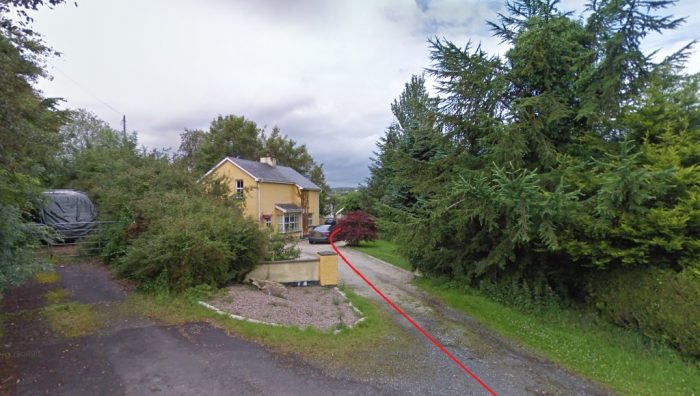 A View from the old main road South showing the route of the old line as it crossed the road and a much extended Gatehouse 60 which appears to make an excellent private home, (Google Streetview). There is little sign here of the main N13 road which runs behind the trees which are just beyond property.
A View from the old main road South showing the route of the old line as it crossed the road and a much extended Gatehouse 60 which appears to make an excellent private home, (Google Streetview). There is little sign here of the main N13 road which runs behind the trees which are just beyond property. Google Maps shows how close the Gatehouse No. 60 is to the new N13 road,(Google Maps).
Google Maps shows how close the Gatehouse No. 60 is to the new N13 road,(Google Maps). This view is taken from the N13 looking back along the old railway alignment towards Strabane. Gatehouse No. 60 can just be made out among the trees, (Google Streetview).
This view is taken from the N13 looking back along the old railway alignment towards Strabane. Gatehouse No. 60 can just be made out among the trees, (Google Streetview). Looking across the N13 and on along the route of the old line towards Gatehouse 61 and Letterkenny, (Google Streetview).
Looking across the N13 and on along the route of the old line towards Gatehouse 61 and Letterkenny, (Google Streetview).
Beyond Gatehouse No. 60, the railway curved round from a Southwesterly trajectory towards the North before crossing the modern day L1114. On the way it crossed a single track lane by means of a bridge.
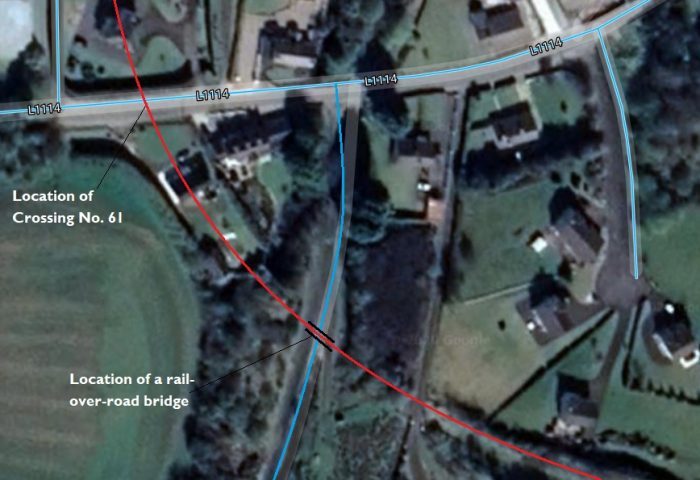 The locations of a bridge and Crossing No. 61, (Google Maps)
The locations of a bridge and Crossing No. 61, (Google Maps)
Reaching the L1114 (at Bonagee Lane) the old railway was now running roughly North/South. The picture below shows the approximate alignment of the old railway where it crossed the L1114. A bungalow has now been built over the line of the old railway. The line was still on embankment at this point and a bridge took it over the L1114.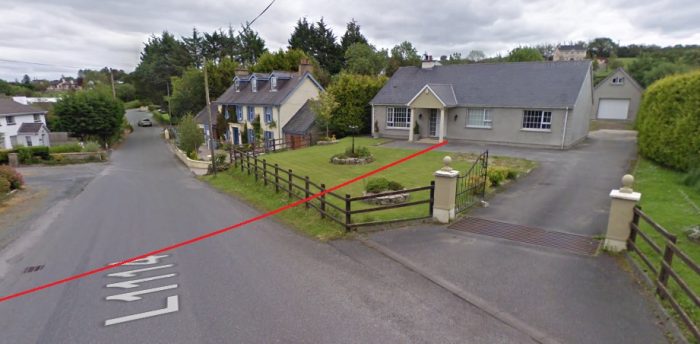 The approximate route of the old railway where it crossed the L1114. A bungalow has now been built on the route of the old line, (Google Streetview).
The approximate route of the old railway where it crossed the L1114. A bungalow has now been built on the route of the old line, (Google Streetview). The 6″ OS Map of the location of the bridges and Gatehouse No. 61. [16]
The 6″ OS Map of the location of the bridges and Gatehouse No. 61. [16]

Gatehouse No. 61 sits some distance North of the Bridge which carried the old railway over the L1114, (Google Maps).
North of the L1114 the railway alignment is not obvious. It ran 50 metres or perhaps less to the East of Bonagee Lane. Travelling North along Bonagee Lane leads to the discovery of what was Gatehouse No. 61. An accommodation lane crossed the railway at this point.
Kerry Doherty very kindly pointed out the location of the Gatehouse, without that help, I doubt that I would have located it. The building has been much extended as the Google Streetview image below shows.
Kerry missed the location himself, despite driving along Bonagee Lane from the North a few days ago. The clue is in the property name on the gatepost which can only be seen from the South and which appears in the image below.

An extended and refurbished Gatehouse No. 61 seen from the South, (Google Streetview). Gatehouse No. 61 is much extended. This photo is a 2011 view from the West on Bonagee Lane, (Google Streetview).
Gatehouse No. 61 is much extended. This photo is a 2011 view from the West on Bonagee Lane, (Google Streetview).
Kerry Doherty provided this link to the location in the archives of the National Library of Ireland – http://catalogue.nli.ie/Record/vtls000731777/MooviewerImg?mobileImage=vtls000731777_001 – on which at the top centre of the image Gatehouse No. 60 is visible. The two arched bridges mentioned above can also be picked out and, in the centre foreground, Gatehouse No. 61 can be seen in its original form. [17]
After Gatehouse No. 61 the old line continued North a short distance to the East of Bonagee Lane, until that lane turned from the North to the Northeast in Bonagee where Gatehouse No. 62 was sited. The crossing was known as Baird’s Crossing and the Keeper’s house can still be seen beyond the railway. It is heavily screened by trees and shrubs but can be seen from the Northeast, as the second image immediately below this text shows. The location of Gatehouse No. 62. the red line is a very approximate representation of the route of the old railway at this point, (Google Streetview).
The location of Gatehouse No. 62. the red line is a very approximate representation of the route of the old railway at this point, (Google Streetview). Baird’s Crossing Cottage (Gatehouse No. 62) seen from the Northeast in 2011. The original cottage has been extended at ground level. The railway ran behind the cottage in this view. Its route is over grown by trees and shrubs, (Google Streetview).
Baird’s Crossing Cottage (Gatehouse No. 62) seen from the Northeast in 2011. The original cottage has been extended at ground level. The railway ran behind the cottage in this view. Its route is over grown by trees and shrubs, (Google Streetview).
The Strabane and Letterkenny Railway crossed the Londonderry and Lough Swilly Railway by means of an over-bridge, (Google Maps).
The Strabane and Letterkenny Railway approached the Londonderry and Lough Swilly Railway from the South at a point which appears in the bottom right of the adjacent map extract from the 1940s. The scale of the map is such that it is impossible to distinguish any indication of the track arrangement at this location and beyond towards Letterkenny.
The Visitor’s Guide to the Londonderry and Lough Swilly Railway [12] shows the Strabane and Letterkenny Railway running for a short distance on the South side of the Londonderry and Lough Swilly Railway (L&LSR), the Strabane and Letterkenny Railway is then shown crossing the route of the Lough Swilly line by means of an over-bridge and then running parallel to it into Letterkenny on the North side of the L&LSR.
That route is illustrated on the adjacent sketch Map. [12]
Other mapping suggests that the point at which the Strabane and Letterkenny Railway crossed the Lough Swilly line was further to the East, close to the point where the former met the L&LSR . This is illustrated on the adjacent later OS Ireland Map. [13]
The location of the rail over rail bridge is shown on Google Maps Satellite imagery of 2020 in the next image below.
From this point on the two lines converged gradually in both vertical and horizontal directions.

The Strabane and Letterkenny Railway crossed the Londonderry and Lough Swilly Railway by means of an over-bridge, (Google Maps).
I have only been able to find a couple of pictorial records of the rail-over-rail bridge myself. both of these are of a relatively poor print quality. They both appear in the same publication: The Londonderry and Lough Swilly Railway: A Visitor’s Guide. [12: p46]. The first shows the bridge as it was in the 1980s, the second in the years when it was still in use.
Kerry Doherty very kindly sent me a colour copy of a photograph of a S&LR train crossing the bridge in May 1959 with No. 5 Drumboe in charge of a goods train. This picture kindly supplied for use in this article by Kerry Doherty. It shows No. 5 Drumboe crossing the rail-over-rail bridge in 1959. By this time the Swilly line was already closed, (c) J.G. Dewing, Color-rail. [6]
This picture kindly supplied for use in this article by Kerry Doherty. It shows No. 5 Drumboe crossing the rail-over-rail bridge in 1959. By this time the Swilly line was already closed, (c) J.G. Dewing, Color-rail. [6]
To the West of this point the two railways passed under an accommodation road. The next photo shows the remains of the bridges at that location. The Swilly railway bridge parapets are close to the camera. The S&LR parapets can be seen in the distance with the metal fencing on the top.


The two railways then encountered the River Swilly and the main road into Letterkenny from the East. Twin structures carried the two railways over the river and the main road. The modern N56 main road and a large roundabout have obliterated almost all of the railway infrastructure at this location. There are some clues as to what it was like in Bell and Flanders book which was written before much of the infrastructure here had been removed. [12:p47]
 The modern N56 bridge over the River Swilly sits on the line of the two old railways, (Google Streetview). The roundabout ahead has almost entirely obliterated the rail-over-road bridges which carried the two railway lines over the Port Road. The only remnant appears in the next image.
The modern N56 bridge over the River Swilly sits on the line of the two old railways, (Google Streetview). The roundabout ahead has almost entirely obliterated the rail-over-road bridges which carried the two railway lines over the Port Road. The only remnant appears in the next image. The North abutment of the S&LR bridge over the old road is all that remains of the two railway bridges at this location, (c) Kerry Doherty. [6]
The North abutment of the S&LR bridge over the old road is all that remains of the two railway bridges at this location, (c) Kerry Doherty. [6]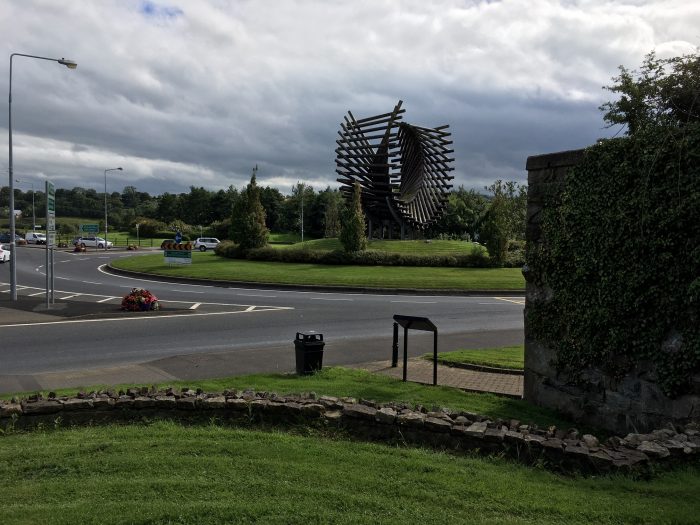 Looking back along the old railway with the remaining bridge abutment to our right, (c) Kerry Doherty. [6]
Looking back along the old railway with the remaining bridge abutment to our right, (c) Kerry Doherty. [6]
The plaque which is visible in both these two photographs carries a drawing of what the old bridge(s) looked like.
The two railway stations sat next to each other just to the East of the centre of Letterkenny. The two lines approached the stations on the South side of the R940. Their approximate route is highlighted on the Google Streetview image below.

Close to the junction between the R940 and Ashlawn the two railways ran very close to the road. Their route is now covered by the tarmac surface of the car parks of the Letterkenny Institute of Technology, (Google Streetview). The blue/mauve and red lines show the approximate alignment of the railways.
The location of the two railway stations includes the car parks of Letterkenny Shopping Centre and the bus station. Two building from the railway ear remain on the site. The old S&LR goods shed is one of these, it has been refurbished and is now called Railway House. The old S&LR goods shed has been refurbished and is now known as Railway House. This image was taken in 2017 from the R940, (Google Streetview).
The old S&LR goods shed has been refurbished and is now known as Railway House. This image was taken in 2017 from the R940, (Google Streetview). The same building as seen from the car park of the Letterkenny Shopping Centre, (c) Kerry Doherty. [6]
The same building as seen from the car park of the Letterkenny Shopping Centre, (c) Kerry Doherty. [6]
The old passenger facilities at the station have been converted in recent years into the town’s Bus Station. This required an extension to the building on what was the track-facing side. Kerry Doherty has generously provided three photographs of the modern building. [6] The front facade of the old Station Building, looking from the Southwest in 2020, (c) Kerry Doherty. [6]
The front facade of the old Station Building, looking from the Southwest in 2020, (c) Kerry Doherty. [6] Inside the extension. The picture shows the old building’s Northeast facing aspect form roughly the position of the buffers stops on the old line. The platform canopy columns have been retained in the new building. The filigree detail has been retained, (c) Kerry Doherty. [6]
Inside the extension. The picture shows the old building’s Northeast facing aspect form roughly the position of the buffers stops on the old line. The platform canopy columns have been retained in the new building. The filigree detail has been retained, (c) Kerry Doherty. [6] Looking along the line of the old platform towards the Passenger Station Building. This facade is modern, (c) Kerry Doherty. [6]
Looking along the line of the old platform towards the Passenger Station Building. This facade is modern, (c) Kerry Doherty. [6] This final present-day image was again provided by Kerry Doherty and shows the station yard crane almost swamped by vegetation, (c) Kerry Doherty. [6]
This final present-day image was again provided by Kerry Doherty and shows the station yard crane almost swamped by vegetation, (c) Kerry Doherty. [6]
We finish this article with a series of pictures of the old S&LR facilities at Letterkenny.
Donegal Railway Heritage Centre posted this next photograph on their Facebook page. In this series of articles about the Co. Donegal Railways, photographs from the Donegal Railway Heritage Centre’s Facebook page are ‘linked-to’ after discussion with and kind permission from Jim McBride.
References
- Edward M Patterson (original author), Joe Begley & Steve Flanders (authors of additional material in the Revised Edition); The County Donegal Railways; Colourpoint Books, Newtownards, Co. Down 2014. As noted in my first article about the Co. Donegal Railways this was to have been my holiday reading while walking different parts of the network, but 2020 has been a strange year!
- https://maps.nls.uk/geo/explore/#zoom=16&lat=54.91092&lon=-7.65886&layers=14&b=1, accessed on 11th October 2020.
- https://commons.wikimedia.org/wiki/File:Athlone,_Cavan_%26_Clara._LetterKenny_Strabane_RJD_113.jpg#/media/File:Athlone,_Cavan_&_Clara._LetterKenny_Strabane_RJD_113.jpg, accessed on 14th July 2020.
- The County Donegal Railways Visitor Guide to the Strabane and Letterkenny Railway is now out of print and i have not been able to find a copy.
- Edward M Patterson (original author), Joe Begley & Steve Flanders (authors of additional material in the Revised Edition); The Lough Swilly Railway; Colourpoint Books, Newtownards, Co. Down 2017. This was also to have been part of my holiday reading, but 2020 has been a strange year!
- Kerry Doherty of Ballindrait very kindly sent me a series of pictures of the Strabane and Letterkenny Railway route. Each of these, in this article, bears the reference number [6]
- https://maps.nls.uk/geo/explore/#zoom=15&lat=54.92484&lon=-7.66844&layers=14&b=1, accessed on 12th October 2020.
- Anthony Burges; The Swilly and the Wee Donegal; Colourpoint Books, Newtownards, Co. Down, Second Impression, 2010.
- https://maps.nls.uk/geo/explore/#zoom=15&lat=54.93626&lon=-7.67260&layers=14&b=1, accessed on 12th October 2020.
- https://maps.nls.uk/geo/explore/#zoom=15&lat=54.94389&lon=-7.68287&layers=14&b=1, accessed on 14th October 2020.
- https://maps.nls.uk/geo/explore/#zoom=15&lat=54.94758&lon=-7.70755&layers=14&b=1, accessed on 27th October 2020.
- Dave Bell and Steve Flanders; The Londonderry and Lough Swilly Railway: A Visitor’s Guide; County Donegal Railway Restoration Society; an small extract from the sketch plan on p42, rotated through 90 degrees.
- http://geohive.maps.arcgis.com/apps/webappviewer/index.html?id=9def898f708b47f19a8d8b7088a100c4, accessed on 27th and 28th October 2020.
- https://www.flickr.com/photos/110691393@N07, accessed on 27th October 2020.
- https://www.facebook.com/DonegalRailwayHeritageCentre/photos, accessed on 28th October 2020.
- http://geohive.maps.arcgis.com/apps/webappviewer/index.html?id=9def898f708b47f19a8d8b7088a100c4, accessed on 10th November 2020.
 http://catalogue.nli.ie/Record/vtls000731777/MooviewerImg?mobileImage=vtls000731777_001, accessed on 10th November 2020 – a thumbnail is provided here , the full size image can be viewed by clicking on the link
http://catalogue.nli.ie/Record/vtls000731777/MooviewerImg?mobileImage=vtls000731777_001, accessed on 10th November 2020 – a thumbnail is provided here , the full size image can be viewed by clicking on the link
